BrahMos: Everything you need to know about the cruise missile system
Defence iq talks to the jv’s general manager and marketing director praveen pathak on brahmos' current status and future plans..


Chasing the world’s fastest jet-launched cruise missile

BRAHMOS BrahMos first drop and launch from a Su-30 MK I
Defence IQ : Typically, a weapon of eight metres in length and close to three tons in weight is typically carried by bombers like the B-1B or Tu-160. This makes the Sukhoi Su-30MK very unique as it is able to carry the BrahMos… P. Pathak : Yes, this is only possible with a unique platform like the Indian Sukhois, itself a class of its own among the fighters. BrahMos is a huge achievement of Russian- Indian military and technical cooperation. These successful achievements from India’s DRDO. Defence Research & Development Organisation] and Russia’s Mashinostroyenia have spread progress and innovation across facilities in both nations. Defence IQ : After several years, tests and trials, can you tell us about the journey to where you currently are with the project? P. Pathak : I’ll start with a brief history. The missile was jointly developed in the late 1990s and 2000s by the Research & Production Association of Machine-Building [in the town of Reutov near Moscow] and our DRDO, thanks to an agreement between the governments of Russia and India, signed on February 12, 1998. BrahMos is a modification of Sovietera anti-ship missiles [Oniks, Yakont] developed by the Reutov Design Bureau in the late 1980s. The name derived from India’s Brahmaputra and Russia’s Moskva rivers. The first test launch was conducted on June 12, 2001, at the Chandipur range in Odisha, India, and subsequently, the missiles began production at enterprises in both countries. Development of these cruise missiles is a natural progression for India, in seeking to develop various platforms for its military arsenal, either on its own or with a partner – but nevertheless, in India. BrahMos is technically a ramjetpowered supersonic cruise missile with a solid propellant booster that can be launched from land-based canisters, submarines, ships and now aircraft. It travels at speeds of Mach 2.8 to 3.0 but is being upgraded in the future to travel at speeds faster than Mach 5.0. for the hypersonic variant.
"BrahMos is technically a ramjet-powered supersonic cruise missile with a solid propellant booster"

BRAHMOS Brahmos has been fired successfully from Indian submarines
Defence IQ : An Indian pilot in Bahrain stated that the latest developments have been particularly challenging and lengthy. Is that the experience you’ve had? P. Pathak : He’s right! Integration efforts onto the flying platform were very complex involving mechanical, electrical and software modifications of the aircraft. The Indian Air Force [IAF] was involved in the development process, as software development of the aircraft was undertaken by the IAF engineers. HAL [state-run Hindustan Aircraft Ltd.] carried out the mechanical and electrical modifications on the aircraft. In addition, the air-launched variant had to be made 500 kg lighter than the land/naval variants. One of the major challenges DRDO scientists had to overcome was the optimisation of transfer-alignment inertial sensors. Thankfully, the experience of the IAF flight test crew and the dedicated and synergetic efforts of the IAF, DRDO and HAL ensured that the integration was smooth. Altogether, it has proven India’s ability to undertake such complex integrations on its own.
"One of the major challenges DRDO scientists had to overcome was the optimisation of transferalignment inertial sensors"
Defence IQ : What tests were undertaken before serial production? P. Pathak : Serial production has been ongoing for the Army and Navy for more than 10 years. Regarding the air variant of BrahMos, there are two important dates. In June 2016, two test-pilots of the ASTE [Aircraft and Systems Testing Establishment, a premier IAF, at Bengaluru] carried out the first flights and carriage-tests with a full weight test-vehicle of BrahMos on a Su-30MKI. RECOMMENDED: How capable is the S-400 missile system? And in November 2017, the IAF successfully fired the BrahMos-A in an anti-shipping configuration from the same frontline fighter aircraft, off the Eastern Coast in the Bay of Bengal. The launch was smooth; it fell for about 100 to 150 metres, ignited and followed the desired trajectory, before directly hitting the target ship. This only succeeded with dedicated support from the Indian Navy, by way of ensuring availability of the targets and a large number of monitoring ships to ensure data collection and range safety clearance. Defence IQ : Excellent! Can you tell us about the accuracy of the 3-tonne missiles? P. Pathak : Recently, a final phase steep dive test of the missile was conducted and it proved to have landed within a range of 10 metres of the targeted area, fired over a range of almost 300 km. Defence IQ : Impressive! With regards to ranges, there was a report that BrahMos now benefits from India’s access to the 34-nation Missile Technology Control Regime. Is this the case? P. Pathak: Yes. In June 2016 India was bound by restrictions that limited the range of the operational missile to less than 300km. We had already experimented with the range from 290km to 400km and then successfully first testfired a variant in March 2017. But, increasing the missile’s range from 400km to a further 800km is now possible after India’s induction into the MTCR. And that is being considered…
"The IAF wants two Squadrons of Su-30 MKIs to be modified to accommodate BrahMos, but HAL is proposing to build new aircraft"

BRAHMOS A Brahmos missile on a HAL Tejas fighter
Defence IQ : Interesting! What can you tell us about the current versions employed by the Army and Navy? P. Pathak : Currently, the Army is equipped with three regiments of Block-III BrahMos, with two fully operational. Last year there was a successful test-firing from a test range at Chandipur along the Odisha coast, to validate some new features like an indigenous Indian seeker. It was to conduct and validate life extension technologies, developed for the first time in India. Our Minister of Defence, Nirmala Sitharaman, congratulated the DRDO scientists for the successful launch with new technology. RECOMMENDED: The future of artillery and long range missile systems: Industry outlook This will result in huge savings in replacement missiles already in the inventory of Indian Forces. Regarding the Navy, induction of the first version of the missile system in the Indian Navy began on [destroyer] INS Rajput, back in in 2005. After two successful test trials from INS Kolkata in June 2014 and February 2015 and a test firing from INS Kochi in September 2015, the newly commissioned ship’s systems were validated. Additionally, we’re starting to see good results incorporating BrahMos into submarines with the first firings from a submerged platform having already taken place. Defence IQ : The two surface ships you mentioned – are they carrying BrahMos in launchers or vertically? P. Pathak : In both, actually. There are older vessels that carry them in side-launchers [INS Ranvir D54, a ‘Kashin’ Class Destroyer Project 61ME], but some have been fitted with a module of the ‘Universal Vertical Launcher’, which is very state-of-the-art. Last October, the Cabinet Committee on Security [through which all Indian defence procurement has to be approved by Prime Minister N. Modi], has cleared the procurement of four Krivak-class frigates from Russia. These will be BrahMos-armed in vertical launchers, two to be built in a Russian shipyard [at Yantar in Kaliningrad], and the other two in India [Goa Shipyard Ltd.]. Defence IQ : And what about the future? At AERO-INDIA there was a blue NG [Next Generation] version shown, under the much smaller LCA [light combat aircraft] Tejas fighter. Is that likely to appear soon? P. Pathak : Quite a lot of planning is ongoing right now. BrahMos- Aerospace is actually working on several future versions, which shouldn’t be confused. A smaller version of the missile, termed Mini BrahMos, will be half the weight of the present missile but with more speed. This is part of independent research by the company to explore if a missile with smaller size can be as effective. Then there is – or will come – BrahMos NG , the latest development that will be launched from submarine torpedo-tubes, and the NG-A, launching also from the Su-30MKI as well as from the LCA Tejas and MiG-29s. A big difference is that, on the Sukhoi, up to five BrahMos-NG missiles could be carried, with two missiles on each wing and one under the fuselage. The MiG-29 and the LCA would carry two. The digitized NG means it comes with a digital fuel injection system that will increase thrust, unlike the current versions that have a mechanical fuel injection system. It also will be even faster, up to Mach 3.5. Defence IQ : So it will be smaller, but will retain the same range? P. Pathak : Yes. BrahMos-NG will have same 290 km range, but it will weigh around 1.5 tons and be 5 meters in length and 50 cm in diameter, making it 50% lighter and three meters shorter than its predecessor. However, having a smaller radar cross-section makes it super fast and harder to detect by anti-missile systems. Defence IQ : Which means it can use smaller platforms and lighter vehicles? P. Pathak : The land variant of the NG missile will be hosted on 8x8 launch vehicles, unlike the older version which used 12x12 launch vehicles. We had earlier designed it for the Navy, but this time it could also develop into an air-to-air version, against slow manoeuvring force multipliers, deep within enemy territory. Defence IQ : Could it serve as an air-to-air AWACS killer even after being fired from the Indian side of the border? Similarly, one supposes it could target enemy refuelling aircraft or transports… P. Pathak : That is within the scope of the system and the engineers are quoting it as quite possible. Defence IQ : What is the current timeframe projected? P. Pathak : A first test firing of the sleeker, lighter NG version could take place within two years, with feasibility studies showing the way forward to integrate it onto the LCA. They have found what modifications need to be done to the LCA’s wing to carry the NG, as well as some changes to the missile. RECOMMENDED: How the APKWS is improving the Hydra-70: BAE Systems interview Full integration, which we think can be expected within four years, will also boost the export potential of the fighter jet, as it would resemble a potent indigenous weapon system that can take down land targets or ships at a distance of almost 300 km.
"Research and development are already on their path to developing the hypersonic variant, called BrahMos II"
Defence IQ : And what about the hypersonic capability? P. Pathak : Research and development are already on their path to developing the hypersonic variant, called BrahMos II. It is projected to double the speed of the current BrahMos, potentially up to Mach 7. Defence IQ : And that will also be named the ‘BrahMos ER’? P. Pathak : The abbreviation ‘ER’ refers to the extended-range version up to 800 km, but not the hypersonic BrahMos-II, which goes even further. We calculate that an 800 km version might be ready for testing by end of this year.
Upcoming Events
Defence transformation.
24 - 26 September 2024 Hilton London Syon Park, London, UK

Countering Explosive Threat & Demining
24 - 25 September, 2024 Copthorne Tara Hotel London Kensington, London, United Kingdom

Uncrewed Systems
24 - 25 September, 2024 Copthorne Tara Hotel, London, UK

Future Mortar Systems
29 - 30 October, 2024 Copthorne Tara Hotel, London, UK

International Dismounted Soldier

International Fighter Conference
05 - 07 November, 2024 Mercure MOA, Berlin

Subscribe to our Free Newsletter
Insights from the world’s foremost thought leaders delivered to your inbox.
Latest Webinars
Why does the ecological transition matter for military vehicle manufacturers.
2022-10-25 09:00 AM - 10:00 AM BST

Securing the Defence Industrial Base: Mitigating Risk and Delivering Resiliency in Physical and Digital Supply Chains
2022-04-21 12:00 PM - 01:00 PM EST

Zero Trust and Air Force Missions
2021-07-27 11:50 PM - 01:30 PM EDT

RECOMMENDED

FIND CONTENT BY TYPE
- Conferences
- Market Reports
- Whitepapers
- Post-Show Reports
Defence IQ COMMUNITY
- Authors & Submission Guide
- User Agreement
- Cookie Policy
ADVERTISE WITH US
Reach Defence professionals through cost-effective marketing opportunities to deliver your message, position yourself as a thought leader, and introduce new products, techniques and strategies to the market.
JOIN THE Defence IQ COMMUNITY
Join Defence IQ today and interact with a vibrant network of professionals, keeping up to date with the industry by accessing our wealth of articles, videos, live conferences and more.

Contact Us | About Us
Become a Member today!
PLEASE ENTER YOUR EMAIL TO JOIN FOR FREE
Already an IQPC Community Member? Sign in Here or Forgot Password Sign up now and get FREE access to our extensive library of reports, infographics, whitepapers, webinars and online events from the world’s foremost thought leaders.
We respect your privacy, by clicking 'Subscribe' you will receive our e-newsletter, including information on Podcasts, Webinars, event discounts, online learning opportunities and agree to our User Agreement. You have the right to object. For further information on how we process and monitor your personal data click here . You can unsubscribe at any time.
- Missiles of the World
The BrahMos (PJ-10) is a short-range, ramjet powered, single warhead, supersonic anti-ship/land attack cruise missile developed and manufactured by India and Russia.
BrahMos at a Glance
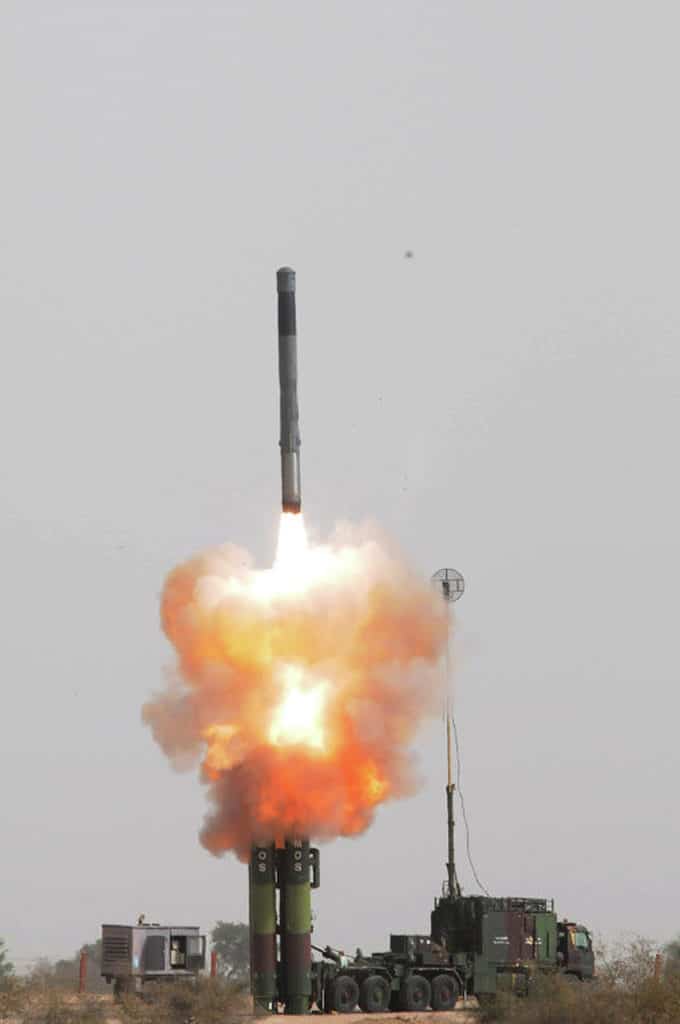
BrahMos Development
Specifications, brahmos hypersonic variant, service history.
In 2016, India agreed to sell Vietnam the Brahmos missile after gaining acceptance into the Missile Technology Control Regime (MTCR). 7 Variants sold internationally only have a range of 290 km to fall under the 300 km restrictions in the MTCR.
- James C. O’Halloran, “Brahmos (PJ-10),” in IHS Jane’s Weapons: Strategic, (IHS; 2015). 142-146.
- Ibid, 142-146
- The Financial Express, “BrahMos missile’s land version successfully test-fired by Indian Air Force,” Yahoo Finance India, May 27, 2016, Accessed on https://in.finance.yahoo.com/news/brahmos-missile-land-version-successfully-080700393.html.
- Zachary Keck, “Russia Developed New Fuel to Power Mach 5 Hypersonic Missiles,” The National Interest, February 17, 2015, Accessed on http://nationalinterest.org/blog/russia-developed-new-fuel-power-mach-5-hypersonic-missiles-12266.
- Sam LaGrone, “India Set to Sell Super Sonic Anti-Ship Cruise Missile to Vietnam,” USNI News, June 1, 2016, Accessed on https://news.usni.org/2016/06/01/india-set-sell-super-sonic-anti-ship-cruise-missile-vietnam-china-upset.
- Latest News

- Entertainment
- Real Estate
- T20 World Cup 2024
- World Cup Schedule 2024
- World Cup Most Wickets
- World Cup Points Table
- Budget 2024
- The Interview
- Web Stories
- Virat Kohli
- Mumbai News
- Bengaluru News
- Daily Digest
- Election Schedule 2024

Army successfully tests BrahMos supersonic cruise missile: All you need to know
Earlier this month, india in a notice to airmen stated that the variant of the cruise missile tested on tuesday (november 29) can hit targets at a range of 450km or more..
The Indian Army has tested a BrahMos supersonic cruise missile from the Andaman and Nicobar (A&N) Islands. The extended range version of the missile was tested by the Western Command of the Army, its sole tri-services command, the islands' DGP tweeted on Tuesday.
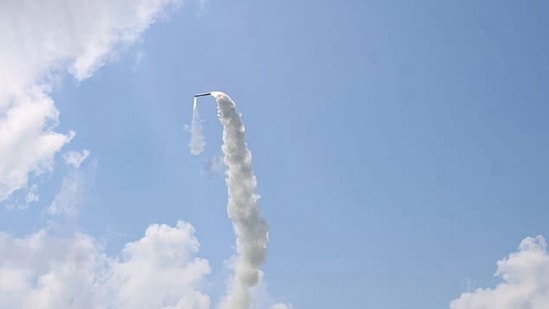
The test came after India issued a notice to Airmen (NOTAM) earlier this month. It the no-fly zone notified for the test, it was suggested that the variant of the cruise missile tested on Tuesday can hit targets at a range of 450km or more.
This year, India conducted many multiple tests of the BrahMos cruise missle from the Andaman and Nicobar Islands.
Here are some of the key things to know about the BrahMos missile:
- An Indo-Russian venture, the Army has been inducting BrahMos regiments since 2007.
- It currently has a flight range of up to 290km with supersonic speed all through the light, ensuring lower dispersion of targets, quicker engagement time and non-interception by any known weapon system in the world.
- The BrahMos cruise missile functions on a “fire and target” mode of operation, adopting varieties of flights on its way to the target. Its cruising altitude can be up to 15km, and terminal altitude is as low as 10 metres. The missile carries a conventional warhead carrying 200 to 300kg.
- BrahMos can be launched from land, sea and air, and has an identical configuration for all three. It is currently in service in all these three areas.
- The missile's current 290km flight range was kept since India was not a part of the Missile Tech Control Regime (MTCH). In 2016, the country joined it and and subsequently, its flight range was allowed to exceed 300km.
Get World Cup ready with Crickit ! From live scores to match stats, catch all the action here. Explore now!
Get Current Updates on India News , Budget 2024 , Weather Today along with Latest News and Top Headlines from India and around the world.
- Brahmos Missile
- Missile Test
Join Hindustan Times
Create free account and unlock exciting features like.

- Terms of use
- Privacy policy
- Weather Today
- HT Newsletters
- Subscription
- Print Ad Rates
- Code of Ethics
- Live Cricket Score
- India Squad
- T20 World Cup Schedule
- Cricket Teams
- Cricket Players
- ICC Rankings
- Cricket Schedule
- Points Table
- T20 World Cup Australia Squad
- Pakistan Squad
- T20 World Cup England Squad
- India T20 World Cup Squad Live
- T20 World Cup Most Wickets
- T20 World Cup New Zealand Squad
- Other Cities
- Income Tax Calculator
- Petrol Prices
- Diesel Prices
- Silver Rate
- Relationships
- Art and Culture
- Taylor Swift: A Primer
- Telugu Cinema
- Tamil Cinema
- Board Exams
- Exam Results
- Competitive Exams
- BBA Colleges
- Engineering Colleges
- Medical Colleges
- BCA Colleges
- Medical Exams
- Engineering Exams
- Horoscope 2024
- Festive Calendar 2024
- Compatibility Calculator
- The Economist Articles
- Lok Sabha States
- Lok Sabha Parties
- Lok Sabha Candidates
- Explainer Video
- On The Record
- Vikram Chandra Daily Wrap
- EPL 2023-24
- ISL 2023-24
- Asian Games 2023
- Public Health
- Economic Policy
- International Affairs
- Climate Change
- Gender Equality
- future tech
- Daily Sudoku
- Daily Crossword
- Daily Word Jumble
- HT Friday Finance
- Explore Hindustan Times
- Privacy Policy
- Terms of Use
- Subscription - Terms of Use
- Skip to Main Content
- Screen Reader Access
Corporate Directory
- Citizen Charter
- Who's who
- Nodal Officer
- Organisation Chart
- Technology Clusters
- Laboratories & Establishments
- Corporate Clusters
- Corporate Directorates
- Product for Export
- Industry Support
- Products for Industry
- ER & IPR
- Research Boards
- Test Facilities
- Technology Foresight
- Publications

BRAHMOS is a universal long range supersonic cruise missile system that can be launched from land, sea and air. BRAHMOS has been jointly developed by DRDO, India, and NPOM, Russia. The system has been designed with two variants for Anti-Ship and Land-Attack roles. BRAHMOS Weapon Systems has been inducted and is operational with the Indian Navy (IN) as well as the Indian Army (IA).
More details on BrahMos can be found at http://brahmos.com

Indian Navy Tests BrahMos Missile With ‘Enhanced Range’ of 900 km
Brahmos aerospace has tripled the range of the supersonic cruise missile from 290km to about 900km since india became a member of mtcr in 2016..
Adithya Krishna Menon 02 Feb 2024
The Indian Navy announced on January 24 that it successfully engaged a land-based target at enhanced range using the BrahMos supersonic cruise missile. Images of the missile launch released by the Navy revealed that the test was conducted from a Rajput-class destroyer, either INS Ranvir or INS Ranvijay .
#IndianNavy & M/s BAPL carried out successful engagement of land target at enhanced range with advanced supersonic cruise missile. This endeavour revalidates #AatmaNirbharta for extended range precision strike capability from combat & misson ready ships. #AatmaNirbharBharat … pic.twitter.com/nfG9tlC2L4 — SpokespersonNavy (@indiannavy) January 24, 2024
The BrahMos is the preferred offensive missile used by the Indian Navy and its various versions are tested often. The January 24 test, which proved “extended range precision strike capability from combat & mission ready ships”, was notable due to the area warning that coincided with the test. A no fly zone was notified between January 24 and 25, with a maximum length of around 900 km. This is the longest known area warning for a BrahMos missile test, strongly indicating that the missile is now capable of reaching ranges of up to 900 km.
The BrahMos missile, a joint project between India and Russia, was initially restricted to a range of 290 km since India was not a partner to the Missile Technology Control Regime (MTCR). India became a member in 2016, and by March 2017 had demonstrated a range of over 400 km for the missile. The modifications included software changes and miniaturisation of some components in the propulsion system.
#AreaWarning #India issues notifications for no fly zone over the Bay Of Bengal & Arabian Sea indicative of likely missile tests Dates | 22-23, 24-25 January 2024 pic.twitter.com/GuFbtTWCmq — Damien Symon (@detresfa_) January 19, 2024
In July 2021, a no fly zone with a maximum length of 760 km was notified. However, this test of BrahMos failed with the booster failing to ignite after launch. In January 2022, a similar zone was notified with a length of about 780 km, and a BrahMos missile with “enhanced capability” was successfully tested.
A final maximum range of about 900 km for the missile was a reported objective of BrahMos Aerospace. The tripling in range since 2016 is also notable because the range extension can be applied to all variants of the missile, including the air launched variant. Older missiles limited to a range of 290 km can also be upgraded for extended range, though whether they can achieve the full 900 km range remains unclear.
Anti-ship variants with 900 km maximum range, when tested, would put into focus the Indian Navy’s requirement for better maritime domain awareness and ISR capabilities in order to utilise such high ranges achievable by the missile. Naval News had earlier reported about India’s growing arsenal of long range naval missiles across speed regimes.
A tweet by BrahMos Aerospace on January 24 stated that the missile had “improved range, firepower & stealth.” The missile is also progressively made Indian, with indigenous content rising from 13% in 2004 to over 75% by 2023. A DRDO lab recently announced the development of fuel for liquid ramjet propulsion which is expected to be used in BrahMos and other projects when cleared for use. The RF seeker, airframe, power supply and booster are among the Indian components tested on the missile since 2018.

Currently, BrahMos Aerospace does not plan to fully indigenize the BrahMos system, with the ramjet engine being the main component still sourced from Russia. However, India is poised to obtain two missiles with near 100% indigenisation, including the ramjet engine, in form of the BrahMos NG as well as the DRDO Supersonic TARget (STAR) program. It is plausible that once projects like STAR are successful and proves the Indian engine technology, BrahMos will also utilise the same.
Three BrahMos batteries had been ordered in shore based configuration by the Philippines, specifically the Marine Corps. DRDO Chairman Dr. Samir V Kamat stated on January 24 that export of ground systems will commence in the “next 10 days” while the missiles are expected to begin delivery by March. The Philippine Army is also expected to procure the missile system.
Related Articles

Philippines Builds First BrahMos Anti-Ship Missile Base Facing South China Sea

U.S. and India Hold Largest Combined Amphibious Exercise to Date
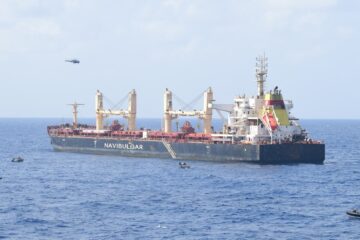
Indian Navy and Air Force Conduct Complex Anti-Piracy Operation
Switch language:

BrahMos Supersonic Cruise Missile
BrahMos is a supersonic cruise missile being developed by BrahMos Aerospace, a joint venture between Defence Research and Development Organisation (DRDO) of India and NPO Mashinostroeyenia (NPOM) of Russia.
Missile Type
Supersonic cruise missile
Manufacturer
BrahMos Aerospace
Indian Army; Indian Navy
Entry into Service
Total weight.
2,500kg-3,000kg
250kg-300kg
Mach 2.8-3.0
Operational Range
Two-stage integrated Rocket / Ramjet
Launch Platform
Ship, submarine, aircraft and land-based mobile launchers
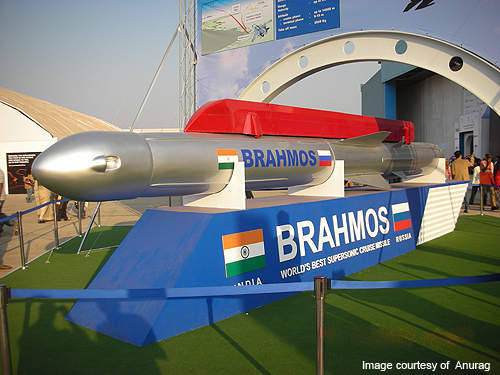
BrahMos is a supersonic cruise missile being developed by BrahMos Aerospace, a joint venture between Defence Research and Development Organisation (DRDO) of India and NPO Mashinostroeyenia (NPOM) of Russia. The missile can be launched against ships and land-based targets. The missile is named after two rivers, the Brahmaputra in India and the Moskva in Russia.
Recommended White Papers
The Rapid Proliferation of UAS and Emerging Threats
Military logistics made smarter and safer: : multilift talon, recommended buyers guides.
CBRN decontamination equipment, solutions and systems
Chemical, biological, radiological and nuclear specialist companies .
BrahMos has a flight range of up to 290km and can reach a maximum speed of Mach 3. The air launched version of the missile is under development as of 2013.
Advanced satellite navigation systems from Russia’s Kh-555 and Kh-101 strategic long-range cruise missiles, and GPS-GLONASS technology were added to the existing doppler-inertial platforms of BrahMos missiles in 2013.
The missile can be installed on ships, submarines, aircraft and ground vehicles. BrahMos missiles are inducted in to the armed forces of India and Russia and can also be exported to friendly nations.
The ‘Fire and Forget’ type missile weights 3t and intercepts surface targets at an altitude of 10m up to 14,000m. In February 2011, the Indian Army placed a $4bn order with BrahMos Aerospace for BrahMos missiles. Deliveries are expected to conclude by 2016. The total value of orders placed by the Indian Navy and Indian Air Force for BrahMos missiles was approximately $9bn as of March 2013.
BrahMos cruise missile development
In February 1998, India and Russia signed an inter-governmental agreement to establish BrahMos Aerospace for producing the BrahMos missiles. The first BrahMos missile was test fired from the integrated test range at Chandipur in Orissa Coast in June 2001. Since then, the missile has been successfully tested from a variety of platforms, including land-based platforms and warships.
In 2008, BrahMos Aerospace acquired Indian state-owned firm Keltec to manufacture and integrate BrahMos components and missile systems. This was necessary to meet the increased orders received from the Indian Army and Navy.
A hypersonic version of the BrahMos, with a speed of Mach 7, is also under development. It is expected to be ready for testing by 2017.
BrahMos design and features
BrahMos is derived from the Russian made P-800 Oniks / Yakhont supersonic anti-ship cruise missile.
The BrahMos propulsion is based on the Oniks, while the guidance system was developed by BrahMos Aerospace.
Related project
Pinaka multibarrel rocket launch (mbrl) system, india.
Pinaka is a multibarrel rocket launch (MBRL) system used by the Indian Army.
The missile can be configured for land, sea and aerial platforms. An aircraft-launched variant (BrahMos A) is currently being configured for the Sukhoi SU-30MKI aircraft of the Indian Air Force (IAF). It features a smaller booster and additional tail fins for greater stability during launch.
The ship and land-based BrahMos missiles can carry a conventional semi-armour-piercing warhead of 200kg, while the aerial variant can carry a 300kg warhead. These missiles can intercept surface targets as low as 10m in altitude.
The deep penetration capabilities of the Brahmos was tested successfully in November 2013 at the Pokhran test range in Rajasthan, India.
BrahMos block-I, block-II and block-III
The land-based BrahMos block-I was successfully test fired twice in December 2004 and March 2007. The missile was inducted in to the Indian Army in June 2007. Block II, the land attack variant of BrahMos, has also been developed. The missile was first tested in January 2009. In September 2010, the missile was test fired at supersonic speeds in a steep-dive mode and created a world record. In December 2010, the BrahMos block-III+ version was successfully test-fired from the integrated test range at Chandipur, off the Orissa Coast, India.
The Indian Army conducted the 32nd test-firing of the BrahMos missile from the integrated test range at Chandipur in July 2012. The test firing was part of development trials to evaluate newer subsystems added to the missile.
The land-based missile system consists of four to six mobile autonomous launchers, a mobile command post and mobile replenishment vehicle. The Indian Army regiment of BRAHMOS-I variant includes 67 missiles, five mobile launchers based on 12×12 Tatra vehicles and two mobile command posts. The first two regiments have been introduced by the Indian Army and the third is being inducted as of 2013.
BrahMos N1 ship-based cruise missile
The ship-based BrahMos N1 is launched either from the inclined or vertical launch platform.
AGM-114 Hellfire II Missile, USA
The AGM-114 II Hellfire is an air-to-ground missile developed primarily for the anti-armour role.
The missile system can be installed on frigates, corvettes, offshore patrol vessels and other types of vessels to attack sea and land-based targets.
BrahMos Aerospace has developed a universal vertical launcher module (UVLM) for the BrahMos N1 missile.
The UVLM can launch up to eight missiles to destroy a group of warships featuring modern anti-missile defence systems.
The first variant of BrahMos N1 has been installed on front-line warships of the Indian Navy from 2005. A highly manoeuvrable variant of the BrahMos missile was successfully test fired in October 2012 from INS Teg, a Talwar Class guided missile frigate of the Indian Navy.
The ship-based cruise missile consists of a fire control system, with high salvo launch capability and enhanced with an inertial navigation system.
BrahMos air launch missile
BrahMos Aerospace has completed the development of an air launch variant. The aircraft launcher is being manufactured in cooperation with the Sukhoi Design Bureau, HAL and IAF. The launch platform is integrated in to the SU-30 MKI aircraft.
Russia signed a contract with India in December 2012, to integrate the BrahMos with the Su-30MKI aircraft for developing an air launch variant of the missile.
The Indian government has decided to lower the weight and strengthen the structure of the aircraft and rocket launcher of the BrahMos in order to make it more suitable for integration with the SU-30 MKI.
The first test for the air launch missile will be carried out by the end of 2013 and the new missile will be inducted in to the IAF in 2014.
BrahMos submarine launch missile
The submarine-launched BrahMos missile was successfully test fired on 20 March 2013 at Vishakhapatnam. India is the only country in the world to own a submarine launched supersonic cruise missile.
The missile can be fitted on a vertical launcher installed in the pressure hull of the submarine. It can be launched from submarines under a water depth of 40m-50m. The missile has a range of 290km and can travel at a speed of Mach 3.
BrahMos-2 hypersonic version
The hypersonic version of the BrahMos missile is under development. It can travel at a speed of Mach 5 to Mach 7. It will be the fastest hypersonic missile in the world, when fully developed.
The Moscow Institute of Aviation, Russia, and a team of scientists of IISc Bangalore will develop new technologies for the hypersonic version.
BrahMos is powered by a two-stage propulsion system. Initial acceleration is provided by a solid-propellant booster and supersonic cruise speed is provided by a liquid-fuelled ramjet system. The air-breathing ramjet propulsion is more fuel-efficient in comparison with conventional rocket propulsion. It provides the BrahMos with a longer range over similar missiles powered by rocket propulsion.
The Global Missiles and Missile Defence Systems Market 2011-2021
This project forms part of our recent analysis and forecasts of the global missiles and missile defence systems market available from our business information platform Strategic Defence Intelligence. For more information click here or contact us: EMEA: +44 20 7936 6783; Americas: +1 415 439 4914; Asia Pacific: +61 2 9947 9709 or via email .
Related Projects
More Projects

US Army puts more than $10bn toward PAC-3 missiles
Emerging dual-use technologies underpin military training in the 21st century, estonian pm nominated for eu security chief, analysis: was bolivia’s failed military coup, really a coup, sign up for our daily news round-up.
Give your business an edge with our leading industry insights.
Sign up to the newsletter
Your corporate email address.
Army Technology In Brief
Global Defence Technology
Thematic Take
I consent to Verdict Media Limited collecting my details provided via this form in accordance with Privacy Policy
Thank you for subscribing
View all newsletters from across the GlobalData Media network.
- International
- Today’s Paper
- T20 World Cup
- Express Shorts
- Mini Crossword
- Premium Stories
- Health & Wellness
Explained: The BrahMos missile, and significance of the ongoing series of tests by Armed forces
A look at the supersonic cruise missile, the significance of its land, sea, and air-launched versions and the strategic posturing behind the ongoing series of tests in the light situation with china and of competition in the strategically important indian ocean region..
India’s Armed forces – Army, Navy, and the Air Force – are conducting back-to-back tests of various versions of BrahMos missile. A look at the supersonic cruise missile, the significance of its land, sea, and air-launched versions and the strategic posturing behind the ongoing series of tests in the light situation with China and of competition in the strategically important Indian Ocean Region.
What is the BrahMos missile which the tri-services are testing?

A combination of the names of Brahmaputra and Moskva rivers, BrahMos missiles are designed, developed and produced by BrahMos Aerospace, a joint venture company set up by Defence Research and Development Organisation (DRDO) and Mashinostroyenia of Russia. Various versions of the BrahMos, including those which can be fired from land, warships, submarines and Sukhoi-30 fighter jets have already been developed and successfully tested in the past. The earliest versions of the ship launched BrahMos and land-based system are in service of the Indian Navy and the Indian Army since 2005 and 2007 respectively.
BrahMos is a two-stage missile with solid propellant booster as first stage and liquid ramjet as the second stage. The cruise missiles like BrahMos are a type of systems known as the ‘standoff range weapons’ which are fired from a range sufficient to allow the attacker to evade defensive fire from the adversary. These weapons are in the arsenal of most major militaries in the world. The versions of the BrahMos that are being tested have an extended range of around 400 kilometers, as compared to its initial range of 290 kilometers, with more versions of higher ranges currently under development.
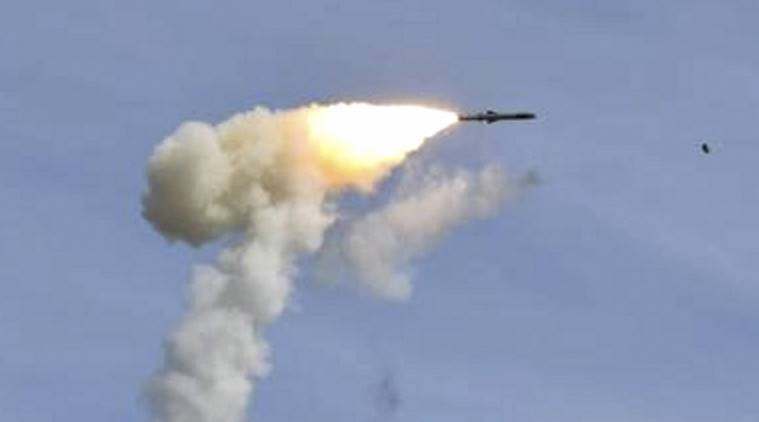
What is the significance of having land, sea and air-launched BrahMos?

The land-based system: The land-based Brahmos Complex has four to six mobile autonomous launchers, with each having three missiles on board that can be fired almost simultaneously. Batteries of the BrahMos missile land based systems have been deployed along India’s land borders in various theatres.
The land attack version of BrahMos has the capability of cruising at 2.8 Mach speed and with the upgraded capability, the missile can hit targets at a range of upto 400 kilometers with precision. Advanced versions of range above 1,000 kilometers and speed upto 5 Mach are said to be under development.
Ship-based system: The Indian Navy began inducting BrahMos on its frontline warships from 2005, and has capability to hit sea-based targets beyond radar horizon. The Naval version has been successful time and again in sea-to-sea and sea-to-land modes. The BrahMos from ship can be launched as a single unit or in a salvo upto eight in numbers separated by 2.5 seconds intervals. These salvos can hit and destroy a group of frigates having modern missile defence systems. BrahMos as a ‘prime strike weapon’ for the ships significantly increases their capability of engaging naval surface targets at long ranges. 📣 Express Explained is now on Telegram
The Air launched version: On November 22, 2017, Brahmos was successfully flight-tested for the first time from the IAF frontline fighter aircraft Sukhoi-30MKI against a sea-based target in the Bay of Bengal and has since been successfully tested multiple times.
BrahMos equipped Sukhoi-30s – which have a range of 1,500 kilometers at a stretch without mid-air refuelling – are considered as key strategic deterrence for the adversaries both along the land borders and in the strategically important Indian Ocean Region. IAF is said to be integrating BrahMos with 40 Sukhoi-30 fighter jets across the various bases.
The submarine launched version: This version has capability of being launched from around 50 meters below the water surface. The canister stored missile is launched vertically from the pressure hull of the submarine and uses different settings for underwater and out of the water flights. This version was successfully tested first in March 2013 from a submerged platform off the coast of Visakhapatnam.
Don’t miss from Explained | Mahatma’s iconic statue, part of Parliament’s identity, site of protest and veneration

What are the ongoing series of tests and the strategic posturing behind it?
On November 24, the Indian Army successfully launched its BrahMos from Car Nicobar Islands in a ‘top-attack’ configuration hitting a target in Bay Bengal. The launch was first in the series of launches of the various versions of missile in coming days in a display of India’s tactical cruise missile triad. Tuesday’s test was followed by two tests — one by the Army and another by IAF — on Wednesday. More tests including those of Naval versions are also slated to take place.
Explaining the significance of these tests, a retired IAF commander said, “While the tests of land, ship and air launched BrahMos have been done time and again, it is rare that they are being tested back-to-back that too in the Indian Ocean Region. These tests certainly project India’s firm strategic posture in the light of situations along the LAC and China ambitions in the Indian Ocean Region. We also need to understand the importance of these live tests from the preparedness point of view. Each test helps these service formations fine-tune their practices, methods and do course correction if needed. Three services doing it back to back also have a tri-service integration significance where land, air and sea assets work in tandem and display a joint deterrence.”
He added, “Land based BrahMos formations along the borders, BrahMos equipped Sukhoi-30s at bases in Northern theatre and and Southern peninsula, and BrahMos capable ships deployed in sea — complete a triad and their successful tests are a strong message to China.”
- An Expert Explains: Why the Santal Hul has been ignored in public memory
- Roads in Ayodhya cave-in: What causes road cave-ins?
- Explained: New crimes under the Bharatiya Nyay Sanhita, and some grey areas
With these back-to-back tests, BrahMos follow the series of tests of over 15 missiles belonging to a vast spectrum of purposes and ranges in September and October. BrahMos too were tested as part this flurry of tests.
On September 30, BrahMos surface-to-surface supersonic Land-Attack Cruise Missile (LACM) featuring an indigenous booster and airframe section along with many other ‘Made in India’ sub-systems was flight tested from ITR. On October 17, the Naval version of the BrahMos was successfully test-fired from Indian Navy’s indigenously-built stealth destroyer INS Chennai, hitting a target in the Arabian Sea. On October 30, a Sukhoi jet that took off from a base in Punjab, hit a target in Bay of Bengal.
Don’t miss from Explained | Muslim ministers: Numbers lag far behind share in population

How an interfaith relationship led to the demolition of 6 Subscriber Only
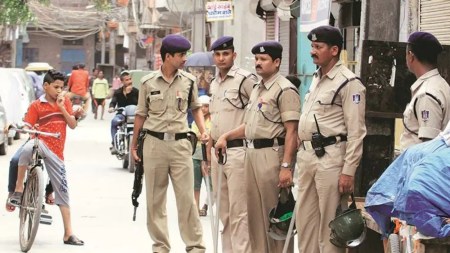
In Bhopal, a race against time as new criminal laws Subscriber Only

The names behind the NEET paper ‘leak’ Subscriber Only

Explained: The story of the Emergency Subscriber Only

Coaching federation proposes reforms for NEET exam

When India was not afraid of foreign correspondents or dissidents Subscriber Only

Significance of new international airport in Tamil Nadu’s Hosur Subscriber Only

BSP risks losing national party status after rout in Lok Subscriber Only

T20 World Cup: Why Hardik Pandya is India’s real Houdini
- Express Explained

Amid allegations of unpaid dues to actors and crew members, the production and distribution company Pooja Entertainment has finally broken its silence on the matter, revealing that Bollywood star Akshay Kumar has stepped in to help resolve the situation. According to a statement, Akshay has insisted on his own payment being placed on hold until everyone is paid.

More Explained

Best of Express

EXPRESS OPINION

Jul 02: Latest News
- 01 Students of Chembur college turned away as institute brings new dress code banning jeans, t-shirt
- 02 Air Europa flight diverted to Brazil after turbulence; 30 injured
- 03 5 killed in Lonavala waterfall mishap: All five bodies recovered, govt to issue orders banning entry of tourists at certain spots
- 04 Posthumous book by Ukrainian author Victoria Amelina will document war crimes since Russian invasion
- 05 ‘New laws will put fear in the minds of criminals’: Maharashtra DGP Rashmi Shukla
- Elections 2024
- Political Pulse
- Entertainment
- Movie Review
- Newsletters
- Web Stories
- Business News
- India Business News
- BrahMos: Building world’s "fastest supersonic cruise missile", future variants & export orders
BrahMos: Building world’s "fastest supersonic cruise missile", future variants & export orders
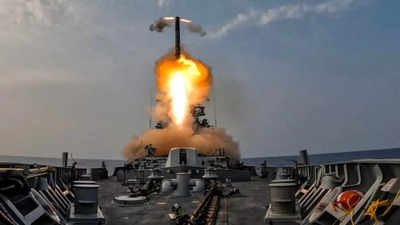
BrahMos missile: Story of World’s Fastest Supersonic Cruise Missile | BrahMos Export | BrahMos NG
PPF Calculator
This financial tool allows one to resolve their queries related to Public Provident Fund account.

FD Calculator
When investing in a fixed deposit, the amount you deposit earns interest as per the prevailing...

NPS Calculator
The National Pension System or NPS is a measure to introduce a degree of financial stability...

Mutual Fund Calculator
Mutual Funds are one of the most incredible investment strategies that offer better returns...

Other Times Group News Sites
Popular categories, hot on the web, trending topics, living and entertainment, latest news.
Here Are 10 Things You Need To Know About BrahMos Supersonic Cruise Missile
The brahmos supersonic cruise missile is difficult to be intercepted by surface to air missiles deployed on leading warships around the world..

The BrahMos supersonic cruise missile has been jointly developed with Russia.
Here is your 10-point cheatsheet to the BrahMos supersonic cruise missile:
The BrahMos is the fastest cruise missile of its class in the world.
BrahMos missile flies almost three times the speed of sound at Mach 2.8 and has a range of 290 km.
The missile has been jointly developed with Russia and is named after the rivers Brahmaputra and Moskva in Russia.
The BrahMos has been inducted into the Navy and Army from 2006 onwards but the latest version is more versatile.
Unlike warships, a BrahMos armed Sukhoi-30 can fly 1,500 kilometres in the direction of a hostile target out at sea.
The BrahMos is extremely difficult to be intercepted by surface to air missiles deployed on leading warships around the world.
The range of the BrahMos missile can be extended up to 400 km as certain technical restrictions were lifted after India became a full member of the Missile Technology Control Regime or MTCR in 2016.
BrahMos missile is the heaviest weapon to be deployed on India's Su-30 fighter aircraft.
The project is expected to be completed by 2020.
The capability of the Indian Air Force to strike from large stand-off ranges on any target in sea or land is expected to go up manifold once the project is completed.

Track Budget 2023 and get Latest News Live on NDTV.com.
Track Latest News Live on NDTV.com and get news updates from India and around the world .
India Elections | Read Latest News on Lok Sabha Elections 2024 Live on NDTV.com . Get Election Schedule , information on candidates, in-depth ground reports and more - #ElectionsWithNDTV
Watch Live News:


Brahmos missile enhances our defence, deterrent capabilities: Philippines envoy Josel Francisco Ignacio
T he Philippines Ambassador to India, Josel Francisco Ignacio, has said that the Brahmos missiles procured from India give a significant boost to his country's defence and deterrent capabilities. The Philippines has signed a deal worth $375 million to purchase three batteries of the BrahMos missile system from India.
Speaking at an ORF media interaction, the ambassador said, "We had a missile deal, between Philippines and Brahmos, that was a contract signed in 2022, and it is a great milestone for both the countries. It is a game changer for the Philippines". The first batch of the export variant of the BrahMos supersonic cruise missile from India arrived in the Philippines on April 19, 2024. The shipment was brought to the Philippines aboard a C-17 Globemaster aircraft of the Indian Air Force.
He highlighted that "Brahmos gives us credible defence and deterrent capabilities. For India, the significance is that it is the first overseas export of the Brahmos, an affirmation of India's own rising capabilities, of its own indigenous defence industry. So, it expands India's defence capabilities footprint overseas. Working with India, Brahmos towards the fulfilment of the full contract".
The BrahMos missile, developed jointly by India's Defence Research and Development Organisation (DRDO) and Russia's NPO Mashinostroyeniya, is a supersonic cruise missile capable of reaching speeds of about 2.8 Mach.
Ambassador Ignacio detailed that the acquisition is part of his country's plans for modernisation. He pointed out, "Philippines has looked at India as one of the main sources of defence equipment for AFP or Armed Forces of Philippines modernization. Our Armed Forces are on the 3rd horizon for revised modernisation program which focuses on defending the archipelago. We are looking to procure ships, aircraft, radar weapons, items that will help boost our maritime domain awareness and defend our entitlements, defend our EEZ."
In addition to missile procurement, the defence relationship between the Philippines and India includes comprehensive military training exchanges. "We also have military training exchanges. Defence cooperation extends to training and education. It is gaining momentum. For the first time since the 1970s, we have Philippines officers training in the Indian military academy in Dehradun. This is the first time in 50 years. We have officers enrolled at the officer training academy in Chennai," the ambassador elaborated.
Also read: Dramatic video shows Chinese coast guards attacking Philippine naval vessels with knives, axes
Maritime cooperation has also seen significant advancement with joint exercises, training, and port calls being undertaken regularly. "We have maritime cooperation, we have seen a flurry of activity, from joint exercises, to training, to port calls, to dialogues. Underpinning the intensification are agreements. Our coast guards have signed an MOU for enhanced maritime cooperation. We are sharing white shipping information, that facilitates exchange on merchant shipping which ultimately contributes to maritime safety and security in the region," Ambassador Ignacio explained.
Watch: Chinese coast guard board Philippines' Navy boat, after ramming into the Filipino vessel
In December 2023, India and the Philippines held a maritime partnership exercise. Last month, Indian Navy ships INS Delhi, INS Shakti and INS Kiltan visited the Philippines. The visit was part of the Operational Deployment of the Indian Navy’s Eastern Fleet to the South China Sea. During the visit, personnel from both navies engaged in a wide range of professional interactions including Subject Matter Expert Exchange (SMEE), sports fixtures, and cross-deck visits.

General Studies
All Programmes
Study Material
BrahMos Missile
Working of brahmos missile, formation of brahmos aerospace.
- BrahMos Missile Series
Versions of BrahMos
Significance of brahmos missile.
Prelims : General Science
Mains : Science and Technology- Developments and their Applications and Effects in Everyday Life. Achievements of Indians in Science & Technology; Indigenization of Technology and Developing New Technology.
BrahMos is a long-range nuclear-capable supersonic cruise missile system. It possesses the capability to be deployed from several platforms, including air, sea, and land. It is capable of travelling at speeds of up to Mach 3, and it is one of the world’s fastest cruise missiles. It was developed by BrahMos Aerospace and tested for the first time in 2001.
BrahMos is named after the rivers Brahmaputra and Moskva (Russia). BrahMos is the potent offensive missile weapon system already inducted into the Armed Forces.
BrahMos is a cruise missile, which is an unmanned self-propelled guided vehicle that flies for the majority of its flight path using aerodynamic lift and whose primary mission is to deliver ordnance or a special payload to a target.
- Launch Platforms: Cruise missiles can be launched from a variety of platforms, including ground, air, sea, and submarine.
- Cruise missiles can fly to their targets at various altitudes as long as they stay within the atmosphere. Most remain close to the Earth's surface, skimming just meters above the ground.
- Their low flight path makes it much more difficult for most radar and sensor systems to detect the missile unless the radar or sensor system is airborne and directed toward the ground.
- Because flying at high altitude saves fuel, it can extend the range of the missile. However, because today's radars and sensors are typically positioned to detect and track high-altitude threats, the missile becomes more vulnerable to missile defence systems.
- Cruise missiles can also combine high and low-altitude flight paths to reap the benefits of both.
- Guidance: Cruise missiles can use a variety of guidance methods to precisely place their ordinance on the desired target while avoiding missile defense systems.
Following the Gulf War of the 1990s , it became increasingly clear that the country needed a cruise missile system. As a result, in 1998, India and Russia signed an intergovernmental agreement in Moscow.
- It paved the way for the formation of BrahMos Aerospace , a joint venture betweenIndia's Defence Research and Development Organization (DRDO) and Russia's NPO Mashinostroyenia (NPOM).
- Objectives: The partnership's goal was to design, develop, manufacture, and market the world's first supersonic cruise missile system- BRAHMOS .
- According to the agreement, the two countries agreed to develop and manufacture the missile jointly, with India owning 50.5% of the JV and Russia owning the remaining 49.5%.
- On June 12, 2001 , the first successful launch of BrahMos occurred. The missile was launched from a land-based launcher at the Interim Test Range off the coast of Chandipur in Orissa.
Brahmos Missile Series
BrahMos is a long-range supersonic cruise missile system capable of being launched from land, sea, or air. BrahMos has been jointly developed by DRDO , India, and NPOM , Russia . BrahMos weapon systems have been inducted and are operational with the Indian Armed Forces. BrahMos missile's trajectory cannot be predicted so easily, which makes it difficult to counter missile defences.
BrahMos Supersonic Cruise Missile
Since its first launch in 2001, it has been upgraded several times, with versions tested on land, air, and sea platforms.
A rapid revolution in military technology worldwide has paved the way for the development of yet another futuristic weapon - BrahMos-NG (Next Generation). BrahMos-NG promises to become one of the most potent weapon systems in the future, carrying forward the excellent lineage of the existing world-class BrahMos.
BrahMos-II, also known as BrahMos Mark II, is a hypersonic cruise missile (HCM). It will be used as a ship-based HCM to increase the offensive capabilities of the Indian Navy in the Indian Ocean region. This will help India counter the growing belligerence of China in the Indo-Pacific region.
A triad of BrahMos, including land-based formations along borders , BrahMos-equipped Sukhoi-30s at bases (Air Force) in the northern theatre and southern peninsula, and BrahMos-capable ships and submarines deployed in the sea.
- As multi-dimensional warfare requirements evolve, the BrahMos is undergoing a number of upgrades, and work is underway to develop versions with greater range, manoeuvrability, and accuracy.
- Versions deployed in all three armed forces are still being tested on a regular basis, as are versions in development.
The missile is highly versatile and its unmatched speed, precision, and power make it the ultimate modern weapon. Developers say that the missile has a strike accuracy rate of 99.99 per cent. A powerful weapon like BrahMos has undoubtedly changed the security dynamics for India in a rapidly evolving regional and global geostrategic order.
- High speed: Operationally, the high speed of the BrahMos gives it better target-penetration characteristics compared to the lighter subsonic cruise missiles, such as Tomahawk .
- Security: The tests of land, ship, and air-launched BrahMos certainly project India’s firm strategic posture in the light of situations along the LAC and China's ambitions in the Indian Ocean Region.
- Self Reliance: The BrahMos model stands as a forerunner to the future of Indian defence manufacturing, sustenance, and the first step towards self-reliance with the creation of a BrahMos Missile Industrial Complex.
- For instance, in 2022, India inked an export deal with the Philippines of a $375 million contract for the BrahMos shore-based anti-ship missile system and talks are also going on with over 12 other countries for exports of BrahMos missiles.
PYQs on BrahMos Missile
Question 1: Consider the following statements: (UPSC Prelims 2023)
- Ballistic missiles are jet-propelled at subsonic speeds throughout their flights, while cruise missiles are rocket-powered only in the initial phase of flight.
- Agni-V is a medium-range supersonic cruise missile, while BrahMos is a solid-fuelled intercontinental ballistic missile.
Which of the statements given above is/are correct?
- Both 1 and 2
- Neither 1 nor 2
Answer: (d)
FAQs on BrahMos Missile
What are the specifications of the brahmos missile.
BrahMos is a two-stage missile with a solid propellant booster engine as its first stage that propels it to supersonic speed before separating. Other features of the missile are the “Fire and Forget” principle of operation and high supersonic speed throughout the flight (up to 290 km).
What is the history of the Brahmos Missile?
The BrahMos Missile was the fastest supersonic cruise missile at the time of its introduction and was the result of a joint venture called BrahMos Aerospace between India’s DRDO and Russia’s NPO Mashinostroyeniya. BrahMos Aerospace was formed in 1998.
What are the specifications of BrahMos II?
The Hypersonic BrahMos II will be inspired by Russia's 3M22 Tsirkon anti-ship hypersonic cruise missile, specifically the scramjet engine technology used in it. The BrahMos-II is expected to have a range of over 300 miles and travel at speeds of up to Mach 7.
© 2024 Vajiram & Ravi. All rights reserved
Flying Under The Radar: A Missile Accident in South Asia

A crashed Indian missile inside Pakistani territory. Image: Pakistan Air Force.
With all eyes turned towards Ukraine these past weeks, it was easy to miss what was almost certainly a historical first: a nuclear-armed state accidentally launching a missile at another nuclear-armed state.*
On the evening of March 9th, during what India subsequently called “routine maintenance and inspection,” a missile was accidentally launched into the territory of Pakistan and impacted near the town of Mian Channu, slightly more than 100 kilometers west of the India-Pakistan border.
Because much of the world’s attention has understandably been focused on Eastern Europe, this story is not getting the attention that it deserves. However, it warrants very serious scrutiny––not only due to the bizarre nature of the accident itself, but also because both India’s and Pakistan’s reactions to the incident reveal that crisis stability between South Asia’s two nuclear rivals may be much less stable than previously believed.
The Incident
Using official statements and open-source clues, it is possible to piece together a relatively complete picture of what took place on the evening of March 9th.
At 18:43:43 Pakistan Standard Time (19:13:43 India Standard Time), the Pakistan Air Force picked up a “high-speed flying object” 104 kilometers inside Indian territory, near Sirsa, in the state of Haryana. According Air Vice Marshal Tariq Zia ––the Director General Public Relations for the Pakistan Air Force––the object traveled in a southwesterly direction at a speed between Mach 2.5 and Mach 3. After traveling between 70 and 80 kilometers, the object turned northwest and crossed the India-Pakistan border at 18:46:45 PKT. The object then continued on the same northwesterly trajectory until it crashed near the Pakistani town of Mian Channu at 18:50:29 PKT.
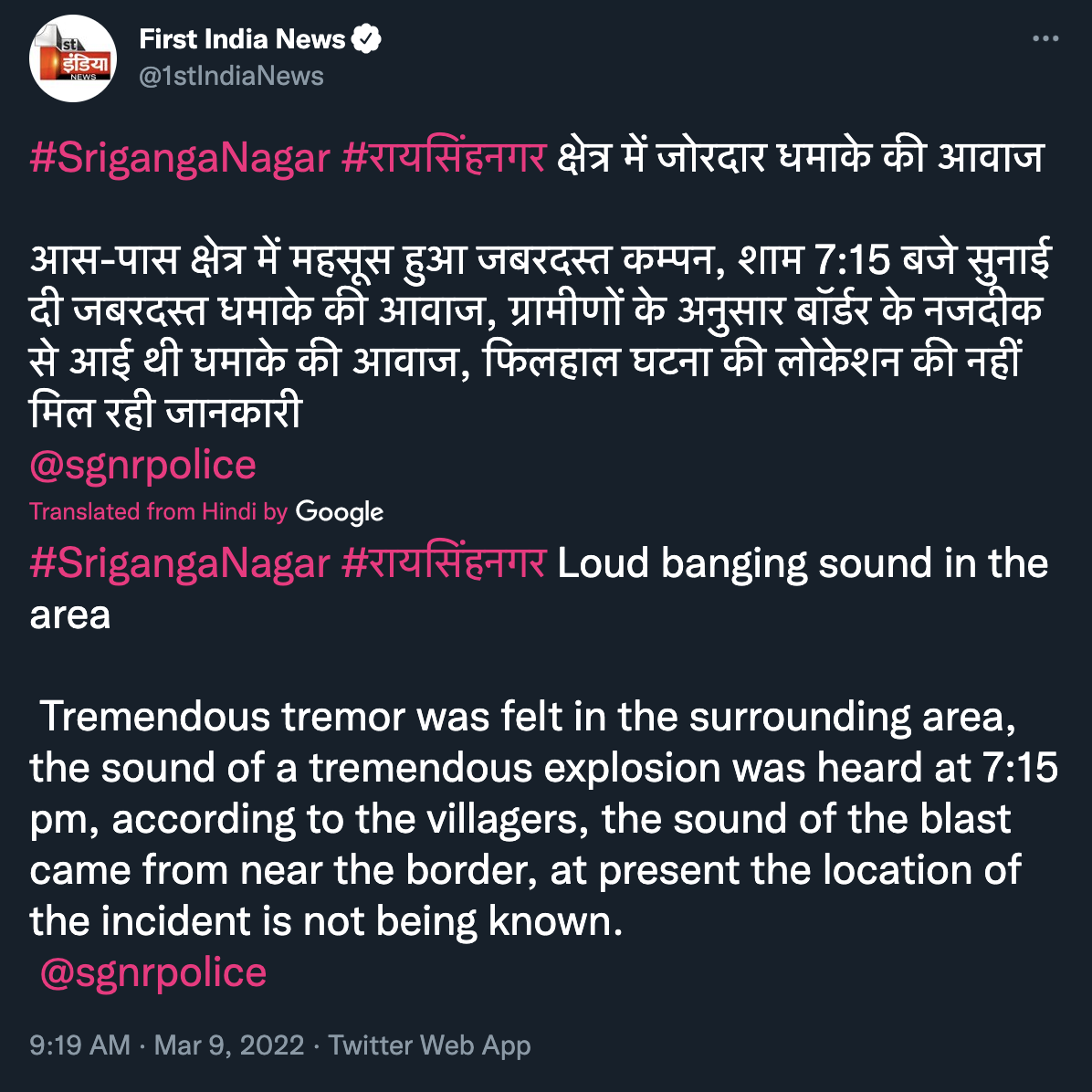
Tweet from @1stIndiaNews indicating that a “tremendous explosion” was heard at approximately 19:15 IST at the city of Sri Ganganagar near the India-Pakistan border. This time and location adds a data point to interpreting the flight path of the missile.
According to Pakistani military officials in a March 10th press conference , 3 minutes and 46 seconds of the object’s total flight time of 6 minutes and 46 seconds were within Pakistani airspace, and the total distance traveled inside of Pakistan was 124 kilometers.

Annotated map of the missile’s flight path provided by Pakistani military officials to media on 10 March 2022.
In a press conference, Pakistani military officials stated that the object was “certainly unarmed” and that no one was injured, although noted that it damaged “civilian property.”
Although the crash site has not been confirmed and official photos include very few useful visual signatures, observation of local civilian social media activity indicates that a likely candidate is the Bakhshu Makhan Hotel, just outside of Mian Channu (30°27’6.40″N, 72°24’10.87″E). One video of the crash site posted to Twitter includes a shot of a uniquely-colored blue building with a white setback roof on the other side of a divided highway. At least two vertical poles can be seen on the roof of the building. All of these signatures appear to match those included in images of the Bakhshu Makhan Hotel in Google Images.
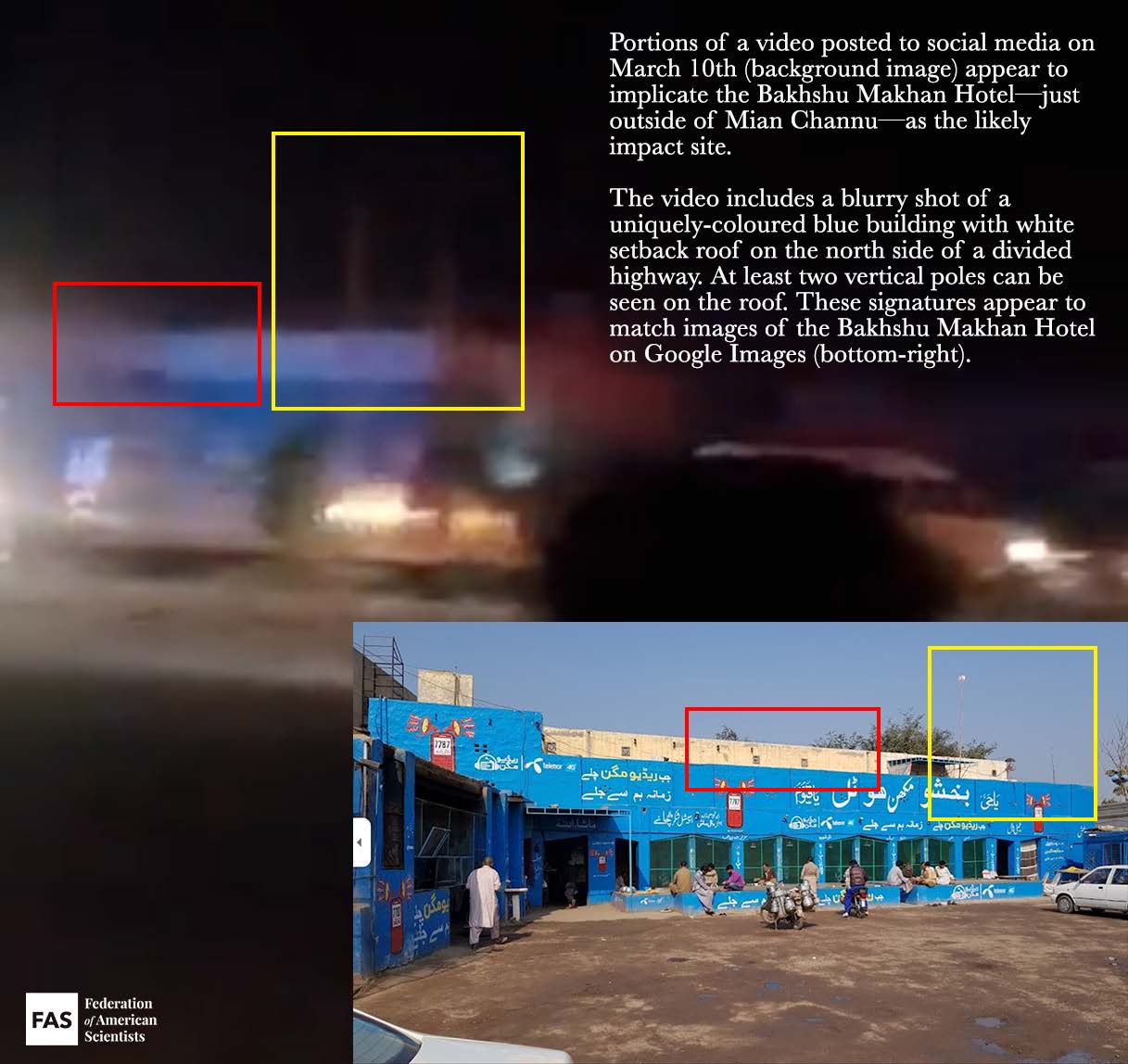
The video’s caption suggests that the object that crashed was an “army aviation aircraft drone;” however, Pakistani military officials subsequently reported that the object was an Indian missile. Neither Pakistan nor India has publicly confirmed what type of missile it was; however, in a March 10th press conference , Pakistani military officials stated that “we can so far deduce that it was a supersonic missile––an unknown missile––and it was launched from the ground, so it was a surface-to-surface missile.”
This statement, in addition to photos of the debris and other official details relating to range, speed, altitude, and flight time of the object, suggest that it was very likely a BrahMos cruise missile.
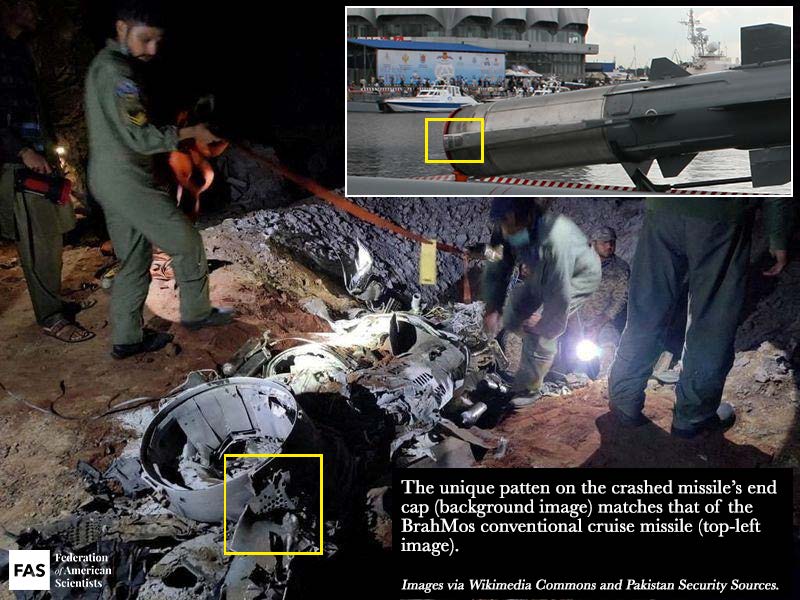
BrahMos is a ramjet-powered, supersonic cruise missile co-developed with Russia, that can be launched from land, sea, and air platforms and can travel at a speed of approximately March 2.8. The US National Air and Space Intelligence Centre (NASIC) suggested that an earlier version of BrahMos had a range of “less than 300” kilometers, but the Indian Ministry of Defence recently announced on 20 January 2022 that it had extended the BrahMos’ range, with defence sources saying that the missile could now travel over 500 kilometres. The reported speed of the “high-speed flying object,” as well as the distance traveled, matches the publicly-known capabilities of the BrahMos cruise missile.
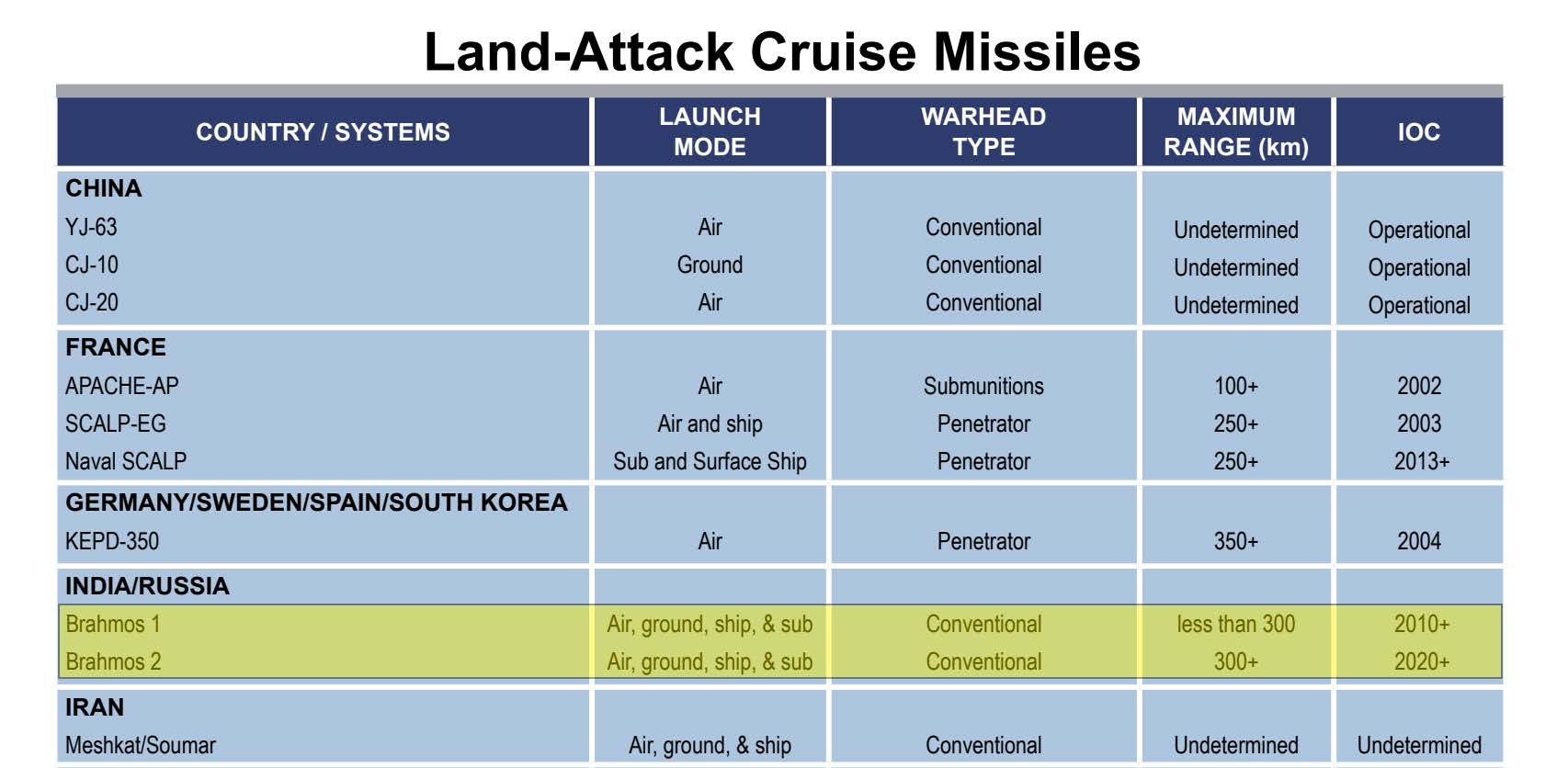
The National Air and Space Intelligence Center’s 2017 Ballistic and Cruise Missile report lists two versions of the BrahMos missile as “conventional.”
Although many Indian media outlets often describe the BrahMos as a nuclear or dual-capable system, NASIC lists it as “conventional,” and there is no public evidence to indicate that the missile can carry nuclear weapons.
India has launched a Court of Inquiry to determine how the incident occurred; however, the Indian government has otherwise remained tight-lipped on details. In the absence of official statements, small snippets have trickled out through Indian and Pakistani media sources––prompting several questions that still need answers.
How did the missile get “accidentally” launched?
According to the Times of India , an audit was being conducted by the Indian Air Force’s Directorate of Air Staff Inspection at the time of the launch. As part of that audit, or possibly as part of a separate exercise, it appears that target coordinates––including mid-flight waypoints––were fed into the missile’s guidance system. According to Indian defence sources , in order to launch the BrahMos, the missile’s mechanical and software safety locks would also have had to be bypassed and the launch codes would have had to be entered into the system.
The BrahMos does not appear to have a self-destruct mechanism––unlike India’s nuclear-armed missiles. As a result, once the missile was launched, there was no way to abort.
Given that defence sources indicate that the missile “was certainly not meant to be launched,” it still remains unclear whether the launch was due to human or technical error. On March 11th, in its first public statement about the incident, the Indian government stated that “a technical malfunction led to the accidental firing of a missile.” However, since the formal convening of a Court of Inquiry, the government has since changed its rhetoric, with Indian officials stating that “the accidental firing took place because of human error. That’s what has emerged at this stage of the inquiry. There were possible lapses on the part of a Group Captain and a few others.” Tribute India reports that there are currently four individuals under investigation.
While this is certainly a plausible explanation for the incident, it is also worth noting that the Indian government would be financially incentivized to emphasize the human error narrative over a technical malfunction narrative. On January 28th, India concluded a $374.96 million deal with the Philippines to export the BrahMos––a deal which amounts to the country’s largest defence export contract. Additional BrahMos exports will be crucial for India to meet its ambitious defence export targets by 2025, and the negative publicity associated with a possible BrahMos technical malfunction could significantly hinder that goal.
Did Pakistan track the missile correctly?
In a press conference on March 10th, Pakistani military officials noted that Pakistan’s “actions, response, everything…it was perfect. We detected it on time, and we took care of it.” However, Indian military officials have publicly disputed Pakistan’s interpretation of the missile’s flight path. Pakistan announced on March 10th that the missile was picked up near Sirsa; however, Indian officials subsequently stated that the missile was launched from a location near Ambala Air Force Station, nearly 175 kilometers away. India’s explanation is likely to be more accurate, given that there is no known BrahMos base near Sirsa, but there is one near Ambala (h/t @tinfoil_globe ). Indian defence sources have also suggested that the map of the missile’s perceived trajectory that the Pakistani military released on March 10th was incorrect.
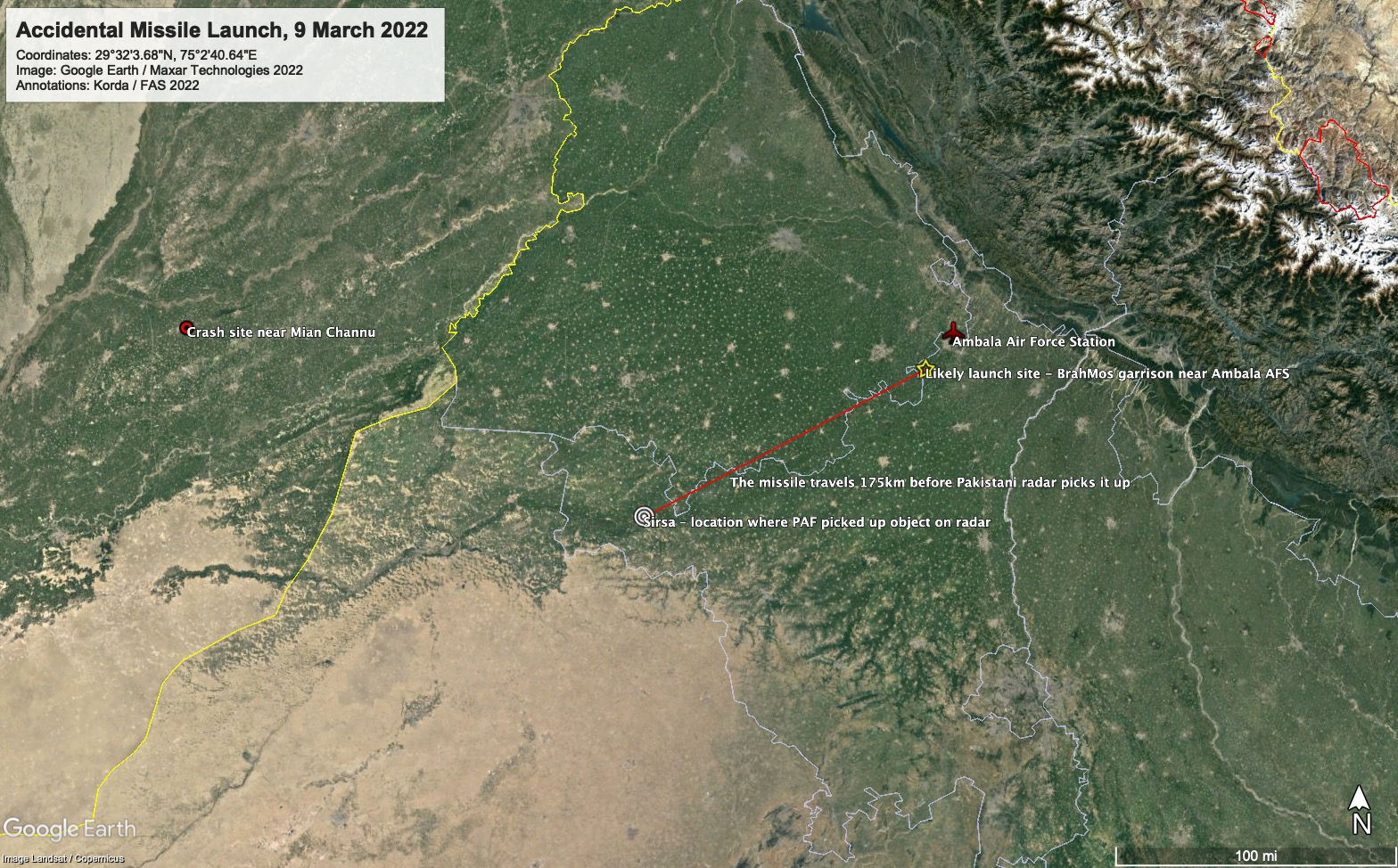
Annotated Google Earth image showing the 175 kilometer distance between the likely launch site and Pakistan’s radar pickup.
Furthermore, Pakistani officials announced on March 10th that the missile’s original destination was likely to be the Mahajan Field Firing Range in Rajasthan, before it suddenly turned and headed northwest into Pakistan. However, Indian defence sources have since suggested that the missile was not actually headed for the Mahajan Field Firing Range, but instead was “follow[ing] the trajectory that it would have in case of a conflict, but ‘certain factors’ played a role in ensuring that any pre-fed target was out of danger.” Given that the impact site was not near any critical military or political infrastructure, this could suggest that the cruise missile had its wartime mid-flight trajectory waypoints pre-loaded into the system, but its actual target had not yet been selected. If this is the case, then this targeting practice would be similar in nature to how some other nuclear-armed states target their missiles at the open ocean during peacetime––precisely in case of incidents like this one. Although the missile still landed on Pakistani territory, the fact that it did not hit any critical targets prevented the crisis from escalating. It is worth noting, however, that this would certainly not be the case if the missile had actually injured or killed anyone.
During the March 10th press conference , Pakistani officials noted that the Pakistan Air Force did not attempt to shoot down the missile because “the measures in place in times of war or in times of escalation are different [from those] in peace time.” However, India’s challenges to Pakistan’s narrative also raise significant questions about whether the Pakistan Air Force was able to accurately track the missile correctly. If not, then this raises the possibility of miscalculation or miscommunication, and crisis stability would be seriously eroded if a similar situation occurred during a time of heightened tensions.
Were any civilian aircraft put in danger?
In its public statements, Pakistan has emphasized that the accidental missile launch could have put civilian flights in danger, as India did not issue a Notice to Airmen (NOTAM) prior to launch. Governments typically issue NOTAMs in conjunction with missile tests, in order to inform civilian aircraft to avoid a particular patch of airspace during the launch window. Given that India did not issue one, a time-lapse video prepared by Flightradar24 showed that there were several civilian flights passing very close to the missile’s flight path at the time of launch. The video erroneously suggests that the missile traveled in a straight line from Ambala to Mian Channu, when it appears to have dog-legged in mid-flight; however, the video is still a useful resource to demonstrate how crowded the skies were at the time of the accident.
A screenshot of a video prepared by Flightradar24, showing that there were several civilian flights passing very close to the missile’s flight path at the time of launch.
Why was India’s response so poor?
Given the seriousness of the incident, India’s delayed response has been particularly striking. Immediately following the accidental launch, India could have alerted Pakistan using its high-level military hotlines ; however, Pakistani officials stated that it did not do so. Additionally, India waited two days after the incident before issuing a short public statement.
India’s poor response to this unprecedented incident has serious implications for crisis stability between the two countries. According to DNA India , in the absence of clarification from India, Pakistan Air Force’s Air Defence Operations Centre immediately suspended all military and civilian aircraft for nearly six hours, and reportedly placed frontline bases and strike aircraft on high alert. Defence sources stated that these bases remained on alert until 13:00 PKT on March 14th. Pakistani officials appeared to confirm this , noting that “whatever procedures were to start, whatever tactical actions had to be taken, they were taken.”
We were very, very lucky
Thankfully, this incident took place during a period of relative peacetime between the two nuclear-armed countries. However, in recent years India and Pakistan have openly engaged in conventional warfare in the context of border skirmishes. In one instance, Pakistani military officials even activated the National Command Authority––the mechanism that directs the country’s nuclear arsenal––as a signal to India. At the time, the spokesperson of the Pakistan Armed Forces not-so-subtly told the media, “I hope you know what the NCA means and what it constitutes.”
If this same accidental launch had taken place during the 2019 Balakot crisis , or a similar incident, India’s actions were woefully deficient and could have propelled the crisis into a very dangerous phase.
Furthermore, as we have written previously , in recent years India’s rocket forces have increasingly worked to “canisterize” their missiles by storing them inside sealed, climate-controlled tubes. In this configuration, the warhead can be permanently mated with the missile instead of having to be installed prior to launch, which would significantly reduce the amount of time needed to launch nuclear weapons in a crisis.
This is a new feature of India’s Strategic Forces Command’s increased emphasis on readiness. In recent years, former senior civilian and military officials have reportedly suggested in interviews that “some portion of India’s nuclear force, particularly those weapons and capabilities designed for use against Pakistan, are now kept at a high state of readiness, capable of being operationalized and released within seconds or minutes in a crisis—not hours, as had been assumed.”
This would likely cause Pakistan to increase the readiness of its missiles as well and shorten its launch procedures––steps that could increase crisis instability and potentially raise the likelihood of nuclear use in a regional crisis. As Vipin Narang and Christopher Clary noted in a 2019 article for International Security , this development “enables India to possibly release a full counterforce strike with few indications to Pakistan that it was coming (a necessary precondition for success). If Pakistan believed that India had a ‘comprehensive first strike’ strategy and with no indication of when a strike was coming, crisis instability would be amplified significantly.”
India’s recent missile accident––and the deficient political and military responses from both parties––suggests that regional crisis instability is less stable than previously assumed. To that end, this crisis should provide an opportunity for both India and Pakistan to collaboratively review their communications procedures, in order to ensure that any future accidents prompt diplomatic responses, rather than military ones.
Background Information:
- “Indian Nuclear Forces, 2020,” FAS Nuclear Notebook, Bulletin of the Atomic Scientists, July/August 2020.
- “Pakistan Nuclear Weapons, 2021,” FAS Nuclear Notebook, Bulletin of the Atomic Scientists, Sept/Oct 2021.
- “India’s Nuclear Arsenal Takes A Big Step Forward,” FAS Strategic Security Blog, Dec 2021.
- Status of World Nuclear Forces, Federation of American Scientists
This article was made possible with generous support from the John D. and Catherine T. MacArthur Foundation, the New-Land Foundation, the Prospect Hill Foundation, and the Ploughshares Fund. The statements made and views expressed are solely the responsibility of the author.
*[Note: This type of missile accident has apparently happened before; on 11 September 1986, a Soviet missile flew more than 1,500 off-course and landed in China. Thank you to the excellent Stephen Schwartz for the historical reference.]
Categories: Arms Control , ballistic missiles , Deterrence , Disarmament , India , Nuclear Weapons , Pakistan
Researchers have many questions about the modernization of Pakistan’s nuclear-capable aircraft and associated air-launched cruise missiles.
The SIPRI chapter describes the nuclear weapon modernization programs underway in each nuclear-armed state and provides estimates for how many nuclear warheads each country possesses.
FAS researchers Hans Kristensen and Matt Korda with the Nuclear Information Project write in the new SIPRI Yearbook 2024, released today.
The total number of U.S. nuclear warheads are now estimated to include 1,770 deployed warheads, 1,938 reserved for operational forces. An additional 1,336 retired warheads are awaiting dismantlement, for a total inventory of 5,044 warheads.

COLOR THEME

BACKGROUND TEXTURE

BACKGROUND IMAGE

- JV Partners
- Team BrahMos
- Pillars of BRAHMOS
- Vision & Mission
- BrahMos Work Centres
- About Missile
- Missile History
- Classification
- BRAHMOS Missile
- Special Features
- Ship Based System
- Land Based System
- Air Launched System
- Submarine System
- Digital Calendar
Press Releases
- BRAHMOS in Media
- Current Openings
- Work Environment
- BrahMos Culture
- Career Prospects
- CSR Activities
- Completed CSR Projects
- Current CSR Projects
- GALLERY Event Gallery

You are Here
Brahmos supersonic cruise missile, with major indigenous systems, successfully test-fired.
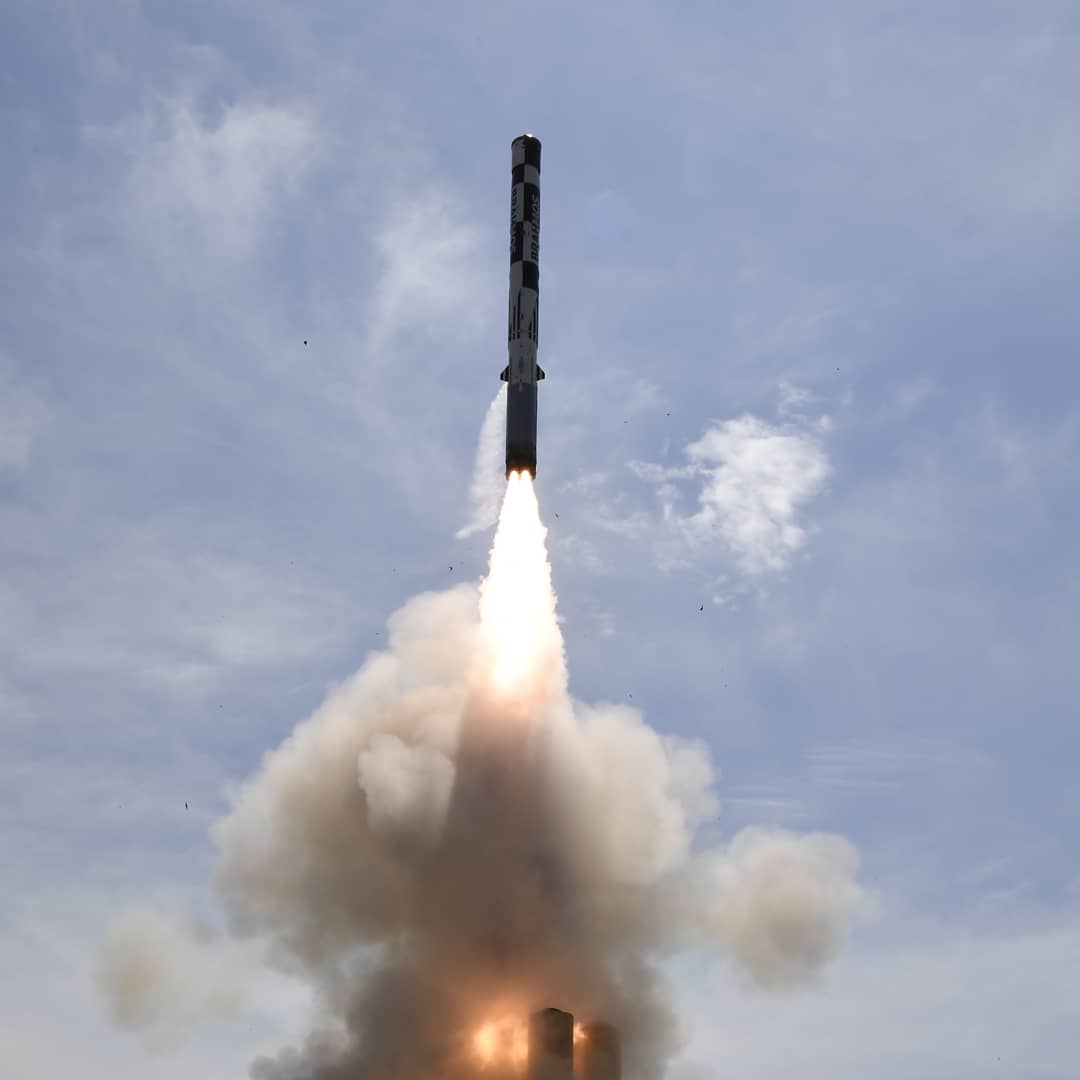
NEW DELHI: BRAHMOS supersonic cruise missile featuring Indian propulsion system, airframe, power supply and other major indigenous components, was successfully test fired at 10.20 AM today from ITR, Chandipur in Odisha. The missile was successfully test-fired for its full range of 290-km during the launch jointly conducted by DRDO and BrahMos Aerospace.
With this successful mission, the indigenous content in the formidable weapon has reached a high value, thus bolstering India’s defence indigenisation and the flagship ‘Make in India’ programme.
Raksha Mantri Shri Rajnath Singh congratulated team DRDO, BrahMos and Industries for today’s successful mission.
Secretary, Department of Defence, R&D and Chairman DRDO, Dr. G. Satheesh Reddy and DG, Missiles and Strategic Systems Shri MSR Prasad also congratulated for the successful launch.
DG (BrahMos) Dr Sudhir Kumar Mishra, Director DRDL Dr Dashrath Ram and Dr BK Das, Director, ITR coordinated and witnessed the entire mission at the launch site and termed the successful flight test as a landmark achievement in enhancing India’s “Make in India” capabilities.
Jointly developed by India and Russia, the versatile BRAHMOS has been operationalised in the Indian Armed Forces with all the three services.
Latest News
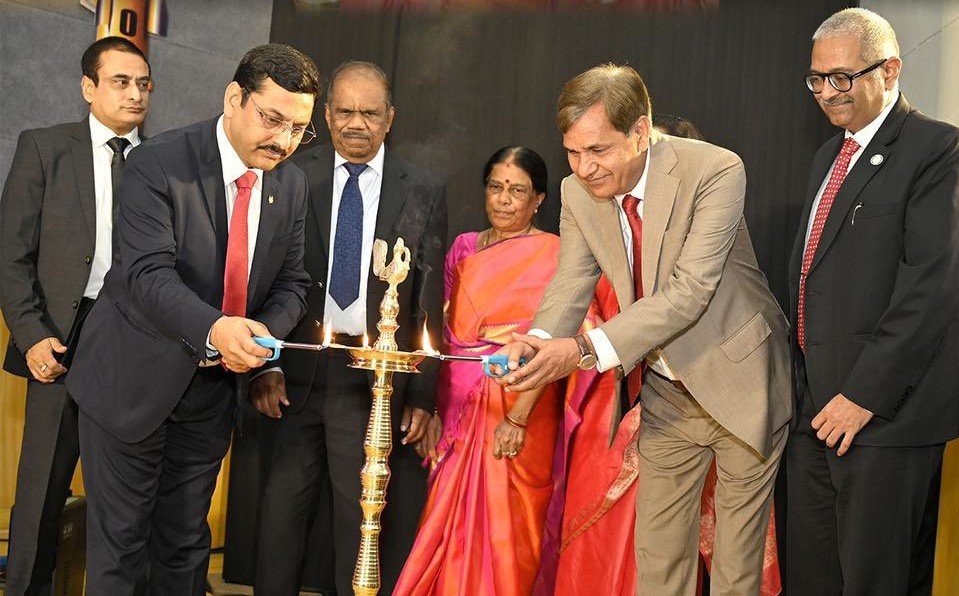
BrahMos Silver Jubilee Year celebrations conclude with grandeur
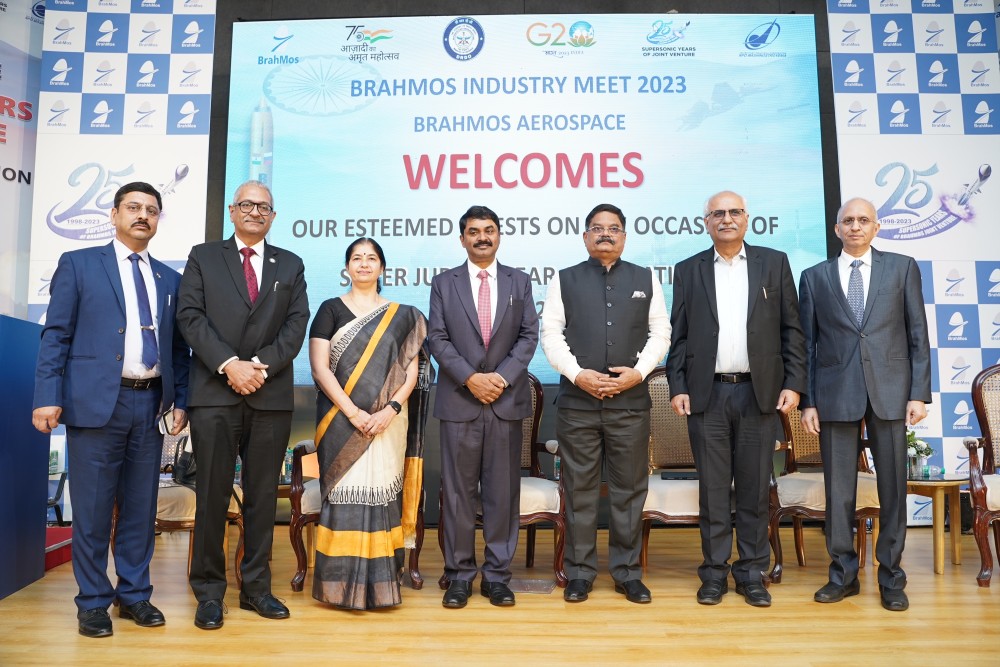
BrahMos JV hosts 'Industry Meet 2023' as part of 'Silver Jubilee' year celebrations
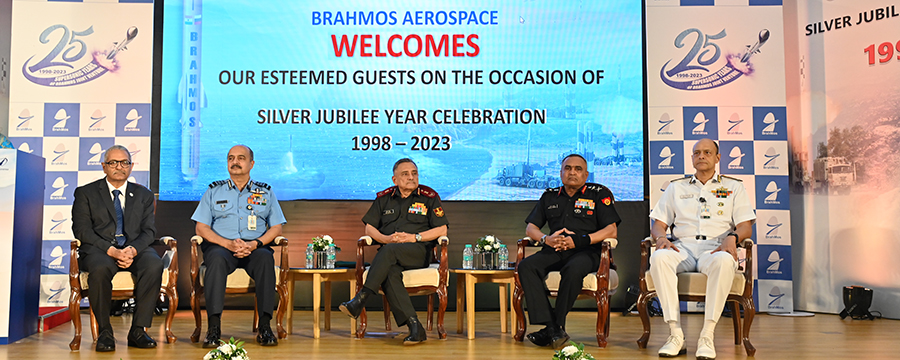
BrahMos marks 25 Supersonic Years of Success with 'BRAHMOS Users' Meet 2023'
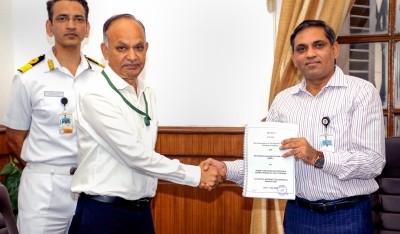
MoD signs a deal for dual role Surface-to-Surface BRAHMOS missile with BAPL
"Every Indian takes pride when he hears that the BrahMos missile 'Made in India' is considered the deadliest and the most advanced in its category. For many countries, the BrahMos missile has emerged as their preferred choice" - Shri Narendra Modi, Prime Minister of India
"The traditional partnership between India & Russia has been tested by the time and time and it is the most important stabilizing factor, not only for the asian region, but for the whole world" - Mr Vladimir Putin, President of Russia
"Time has come for BrahMos Aerospace to work on Mark-II version of BRAHMOS so that we will still be the market leader in hypersonic cruise missiles." - Dr. APJ Abdul Kalam, Former President of India
"In Geopolitics, only a strong Nation can advocate peace. And a powerful weapon like BRAHMOS can give strength to India to advocate peace in the world" - Dr. A.S. Pillai, Founder CEO & MD BrahMos Aerospace
"BrahMos is not only a successful Joint Venture but also a model for cooperation which has immense political value for our two countries" - Mr. Dmitry Rogozin
Defence Minister Shri Rajnath Singh releases Brahmand World Defence Update 2022
BrahMos Aerospace commences Silver Jubilee Year celebrations 2022-2023
BRAHMOS - NG
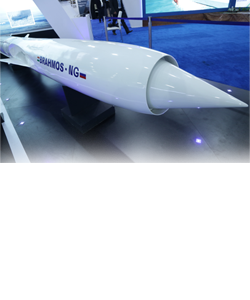
CEO & MD Desk
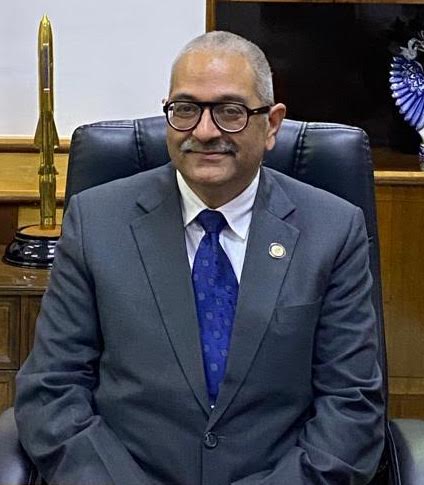
Shri Atul Dinkar Rane Outstanding Scientist Director General, BrahMos, DRDO CEO & MD, BrahMos Aerospace ✉ ceomd[at]brahmos[dot]com Read More

BrahMos Aerospace Private Limited ( CIN - U74899DL1995PTC074334) 16, Cariappa Marg, Kirby Place, Cantt, New Delhi 110010 Tel: +91-11-42285000 , Fax: +91-11-25684827, Email - mail[at]brahmos[dot]com Contact Person: Mr Praveen Pathak, Director (MP&E) & Corporate IT HoD
DRDO Terms of Use Site Map Calendar --> Contact Us Copyright 2022 by BrahMos Aerospace. All Rights Reserved

To improve the performance of our website, show the most relevant news products and targeted advertising, we collect technical impersonal information about you, including through the tools of our partners. You can find a detailed description of how we use your data in our Privacy Policy . For a detailed description of the technologies, please see the Cookie and Automatic Logging Policy .
By clicking on the "Accept & Close" button, you provide your explicit consent to the processing of your data to achieve the above goal.
You can withdraw your consent using the method specified in the Privacy Policy .
BrahMos Missiles Will Make India's Project 75I Submarine Worldclass
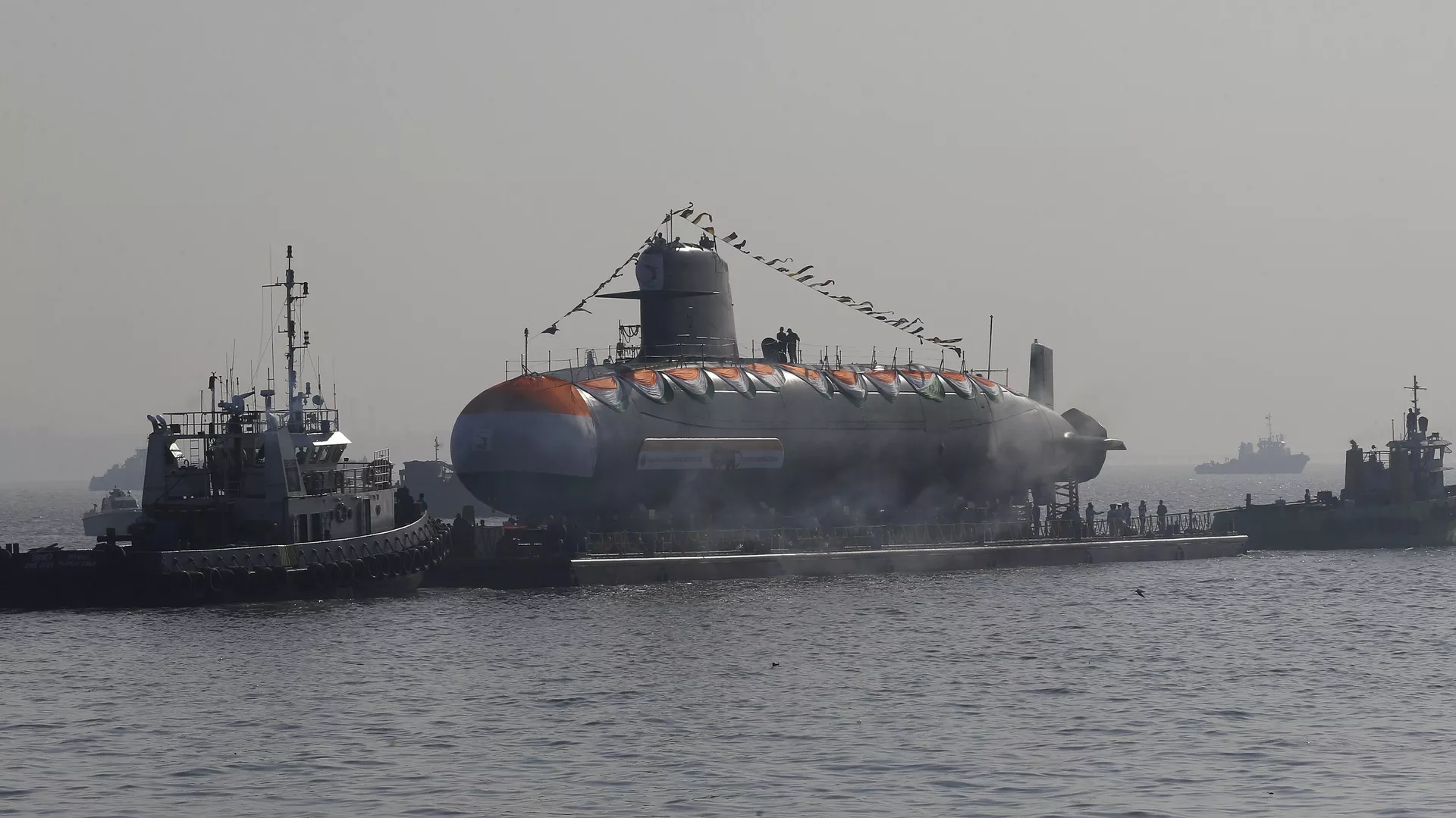
Project 75I
The Strategic Partnership Model (SPM ) aims to enhance indigenous capabilities by fostering collaboration between Indian private companies and foreign Original Equipment Manufacturers (OEMs).
Qualitative Requirements
Procurement progress, technical challenges.
Plugging an additional section into an operationally deployed submarine is fraught with risks because it will change the physical characteristics of the submarine, which in turn could negatively impact its stealth, speed and manoeuvrability characteristics.
"Naturally, such cooperation would involve the transfer of all technologies for its creation. Moreover, we offer the installation of the BrahMos missile system on this boat. This project can be successfully implemented in the interests of the two countries", Drozhzhov stressed.
In the years ahead, Brahmos Aerospace is likely to develop more advanced, longer range variants of the Brahmos, which would make the Project 75I submarine even more potent.
- Sputnik Opinion
- Science & Tech
- Ministry of Defence (MoD)
- Rosoboronexport
- South Korea
- BrahMos Supersonic Cruise Missile
- Terms of Use
- Cookie Policy
- Privacy Policy
- Privacy Feedback

COMMENTS
The BrahMos (also designated as PJ-10) [14] is a medium-range ramjet supersonic cruise missile that can be launched from submarines, ships, fighter aircraft or TEL. [15] It is a joint venture between the Indian Defence Research and Development Organisation (DRDO) and the Russian Federation 's NPO Mashinostroyeniya, who together have formed ...
BrahMos is technically a ramjetpowered supersonic cruise missile with a solid propellant booster that can be launched from land-based canisters, submarines, ships and now aircraft. It travels at speeds of Mach 2.8 to 3.0 but is being upgraded in the future to travel at speeds faster than Mach 5.0. for the hypersonic variant.
BrahMos-II or BrahMos-2 or BrahMos Mark II is a hypersonic scramjet -propelled missile currently under joint development by India 's Defence Research and Development Organisation and Russia 's NPO Mashinostroyenia, which have together formed BrahMos Aerospace Private Limited. The BrahMos-II is expected to have a range of 1,500 kilometres (930 ...
BrahMos is a short-range, ramjet powered, single warhead, supersonic anti-ship/land attack cruise missile developed and manufactured by India and Russia. It has a range of 300-500 km, a speed of Mach 2.0-2.8, and a stealth design.
BRAHMOS is a two-stage missile with a solid propellant booster engine as its first stage which brings it to supersonic speed and then gets separated. The liquid ramjet or the second stage then takes the missile closer to 3 Mach speed in cruise phase. Stealth technology and guidance system with advanced embedded software provides the missile with special features.
The Indian Army has tested a BrahMos supersonic cruise missile from the Andaman and Nicobar (A&N) Islands. The extended range version of the missile was tested by the Western Command of the Army ...
BRAHMOS is a universal long range supersonic cruise missile system that can be launched from land, sea and air. BRAHMOS has been jointly developed by DRDO, India, and NPOM, Russia. The system has been designed with two variants for Anti-Ship and Land-Attack roles. BRAHMOS Weapon Systems has been inducted and is operational with the Indian Navy (IN) as well as the Indian Army (IA).
BrahMos marks 25 Supersonic Years of Success with 'BRAHMOS Users' Meet 2023' MoD signs a deal for dual role Surface-to-Surface BRAHMOS missile with BAPL. Defence Minister Shri Rajnath Singh releases Brahmand World Defence Update 2022. BrahMos Aerospace commences Silver Jubilee Year celebrations 2022-2023
NEW DELHI: BRAHMOS supersonic cruise missile, with increased indigenous content and improved performance, was successfully test-fired from Integrated Test Range, Chandipur off the coast of Odisha at 1030 hrs on January 20, 2022. The launch was conducted by Brahmos Aerospace in close coordination with the teams of Defence Research and Development Organisation (DRDO).
India's BrahMos supersonic cruise missiles were delivered to the Philippines on Friday (April 19), as part of a $375 million deal signed by the two countries in 2022, news agency ANI reported. Prime Minister Narendra Modi also referenced it in an election rally in Madhya Pradesh, saying, "Bharat is acquiring the image of an arms exporter ...
Manila's first BrahMos missile base in Western Luzon positions the supersonic anti-ship cruise missiles to strike targets 290-300 kilometers away. Scarborough Shoal, a disputed feature between the Philippines and China that has been de facto occupied by Beijing's naval forces since 2012, is roughly 250 kilometers from the new base.
The BrahMos is a supersonic cruise missile jointly developed by India and Russia, which has tripled its range since 2016. The latest test by the Indian Navy involved a Rajput-class destroyer and a no fly zone of 900 km, indicating the missile's extended capability.
A model of the BrahMos missile autonomous ground launcher shown at MAKS-2009. BrahMos is the world's fastest supersonic cruise missile, developed by BrahMos Aerospace. BrahMos supersonic cruise missile displayed at IMDS-2007. The Indian Air Force's SU-30 MKI aircraft will be fitted with the BrahMos air launch missile variant by 2014.
India's Armed forces - Army, Navy, and the Air Force - are conducting back-to-back tests of various versions of BrahMos missile. A look at the supersonic cruise missile, the significance of its land, sea, and air-launched versions and the strategic posturing behind the ongoing series of tests in the light situation with China and of competition in the strategically important Indian Ocean ...
BrahMos is said to be the world's "fastest supersonic cruise missile" - and it is the frontline weapon for all the three arms - Indian Navy, Indian Army and the Indian Air Force.
The BrahMos is the fastest cruise missile of its class in the world. BrahMos missile flies almost three times the speed of sound at Mach 2.8 and has a range of 290 km. The missile has been jointly ...
A BrahMos supersonic cruise missile was successfully test-fired from the Indian Navy's frontline guided missile destroyer INS Mormugao, officials said on May 14. The missile firing demonstrated ...
The BrahMos missile, developed jointly by India's Defence Research and Development Organisation (DRDO) and Russia's NPO Mashinostroyeniya, is a supersonic cruise missile capable of reaching speeds ...
BrahMos is a long-range nuclear-capable supersonic cruise missile system. It possesses the capability to be deployed from several platforms, including air, sea, and land. It is capable of travelling at speeds of up to Mach 3, and it is one of the world's fastest cruise missiles. It was developed by BrahMos Aerospace and tested for the first ...
This time and location adds a data point to interpreting the flight path of the missile. According to Pakistani military officials in a March 10th press conference , 3 minutes and 46 seconds of the object's total flight time of 6 minutes and 46 seconds were within Pakistani airspace, and the total distance traveled inside of Pakistan was 124 ...
In January 2022, the Philippines concluded a $375 million deal with India for three batteries of shore-based anti-ship variant of the BrahMos supersonic cruise missiles, becoming the first export ...
The test firing comes three months after the BRAHMOS cruise missile was successfully test fired for the first time from the Indian Air Force's frontline Sukhoi-30 MKI combat jet. "Formidable Supersonic Cruise Missile #BrahMos was successfully flight tested at 8:42 AM today at Pokhran test range, Rajasthan.
NEW DELHI: BRAHMOS supersonic cruise missile featuring Indian propulsion system, airframe, power supply and other major indigenous components, was successfully test fired at 10.20 AM today from ITR, Chandipur in Odisha.The missile was successfully test-fired for its full range of 290-km during the launch jointly conducted by DRDO and BrahMos Aerospace.
The Indian Army's BrahMos supersonic cruise missiles mounted on Mobile Autonomous Launchers (MAL) India and Russia have jointly developed the supersonic cruise missile BrahMos. There are three versions of the Brahmos: ship/land-launched, air-launched, and sub-launched. The ship/land-launched version was operational as of late 2007.
The Brahmos is always pitched as a supersonic cruise missile that can be launched from land, ships, submarines and aircraft. India has operationally deployed land, ship and air launched variants of the missile extensively since the Indian Navy operationally inducted the missile on November 18, 2005 on INS Rajput.